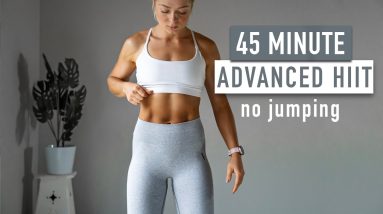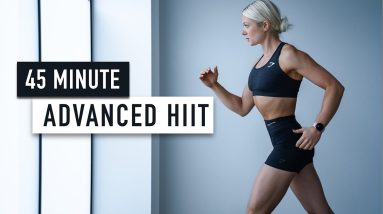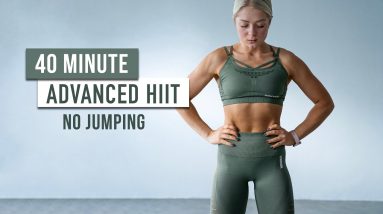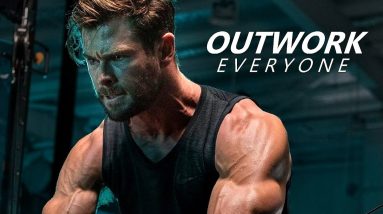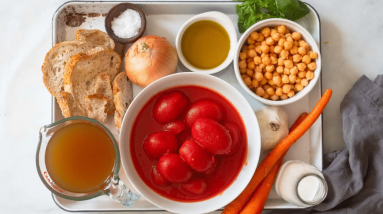
Get Ready for Soup Season with Our Top Healthy Tuscan Soup Recipe
As the temperatures start to drop, we start craving soup. This healthy Tuscan tomato soup recipe is a favorite since it’s super simple to make with a few pantry staples like canned tomatoes, chickpeas, and day-old bread!
Our take on a Tuscan tomato soup (also known as pappa al pomodoro) adds chickpeas for extra plant-based protein and texture. If you are looking for a delicious but healthy homemade tomato soup that is thick and creamy without the need for heavy cream – you’ll love our Tuscan tomato bread soup.
We were honestly so shocked by the creaminess of this soup because it tastes like it has cream, but it is actually dairy-free. Blending half of the soup in a blender and adding the bread to the soup base creates a creamy texture without any heavy cream.
Check out the details for our healthy Tuscan Soup, a few helpful FAQs, followed by the full, delicious recipe.
The Ingredients 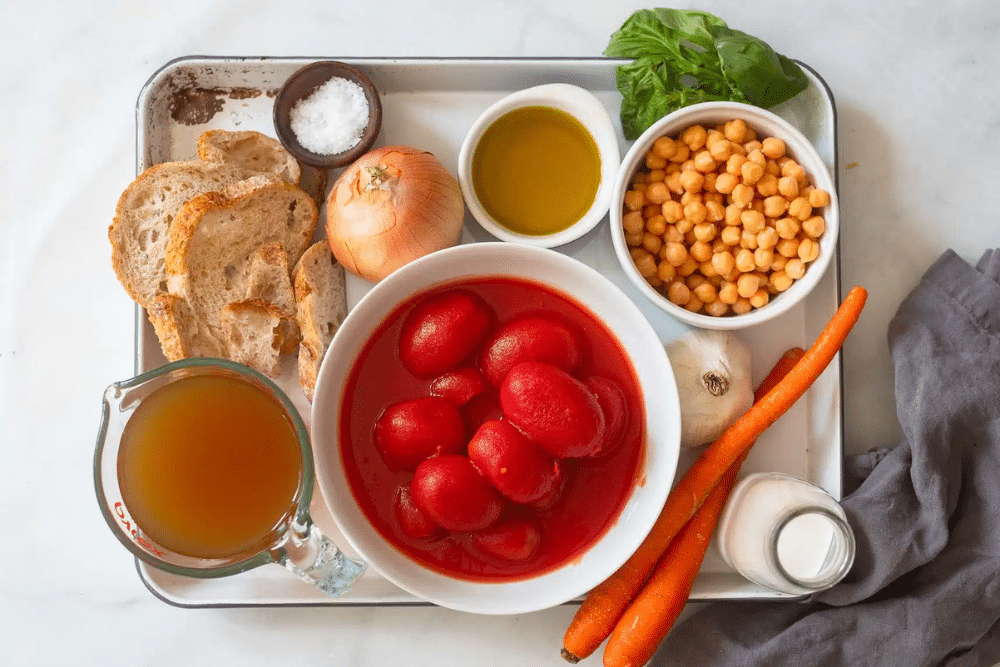 Photo Credit: Get Healthy U
Photo Credit: Get Healthy U
To make our healthy Tuscan soup, you’ll need:
- Canned Tomatoes: we recommend using a higher quality canned tomato like San Marzano tomatoes if you can since they add so much flavor to this simple soup. We prefer whole, peeled tomatoes.
- Onion, Garlic and Carrot: this combo of veggies adds tons of flavor to this soup. If you don’t have fresh garlic, you can substitute with 2 teaspoons of garlic powder.
- Broth: use a flavorful broth for best results. Use vegetable broth for a vegan version of this soup or else you can use chicken stock. For those that need to limit their sodium intake, use a low sodium broth.
- Chickpeas: add some plant-based protein and texture to this simple soup by tossing in a can of drained chickpeas. If you don’t have chickpeas, you can substitute with white beans or butter beans.
- Basil: fresh basil is a perfect pairing with tomatoes. We use fresh basil but you can also use dried basil – we recommend adding about 1 teaspoon dried basil. If you don’t have basil, you can also use a teaspoon of Italian seasoning.
- Bread: cube up day-old or stale bread to thicken this soup. We used a sourdough loaf, but any soft white bread will also work well for this Tuscan soup recipe. You just want to avoid using a whole grain or seedy loaf as the grains and seeds do not break down into the soup.
The Details 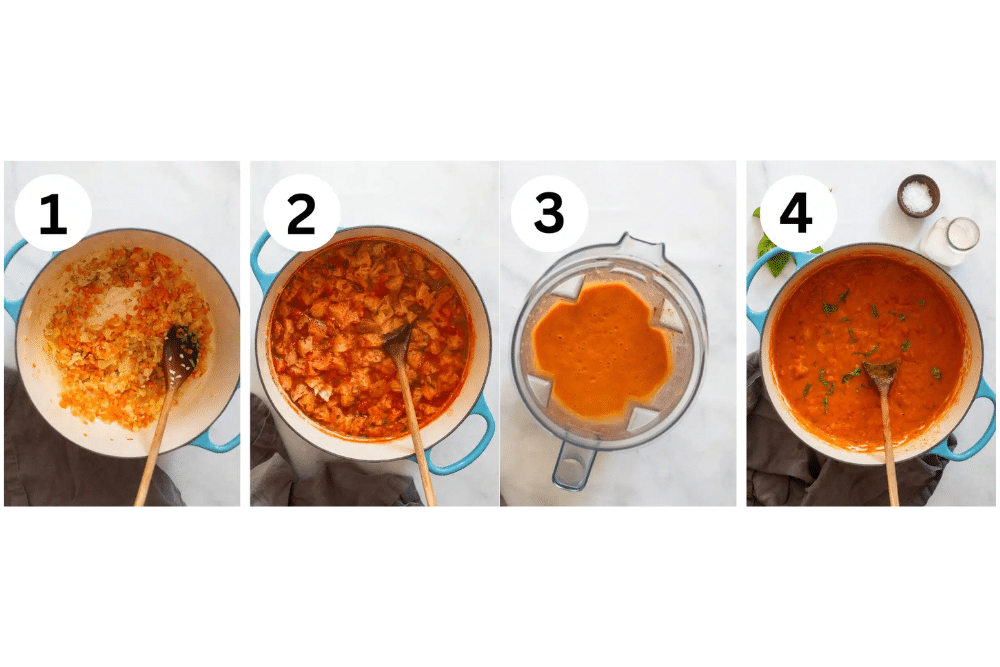 Photo Credit: Get Healthy U
Photo Credit: Get Healthy U
Here are the detailed instructions for our healthy Tuscan soup:
- Saute the Onion and Carrot: start by adding olive oil, diced carrots, and onion to a large dutch oven or large stock pot over medium-high heat. Saute until the onion is translucent. Stir in the garlic and cook for 1 more minute.
- Simmer with the Other Ingredients: Meanwhile, add the canned tomatoes to a large bowl and crush them by hand. Add them to the pot with broth, chickpeas, and basil. Simmer and then add the day-old bread. Simmer until the bread is softened.
- Blend Half: add ½ of the soup to a blender and puree until smooth (or use an immersion blender to partially blend the soup). Stir back into the rest of the soup. Serve with parmesan cheese, olive oil, and more fresh basil leaves.
Tuscan Soup FAQs  Photo Credit: Get Healthy U
Photo Credit: Get Healthy U
Is this Tuscan soup healthy?
Yes! This healthy tomato basil soup recipe is made without heavy cream but is instead thickened with bread which reduces the total calories. Tomatoes are a good source of several essential nutrients like vitamin C which supports a healthy immune system and potassium, an electrolyte, which is beneficial for blood pressure regulation.
The red color of tomatoes comes from a red pigdment and antioxidant called lycopene. Processed tomatoes (like canned tomatoes) are much higher in lycopene than fresh tomatoes. Those who eat more lycopene rich foods may have a lower risk of heart disease and cancer.
How many calories in tomato soup?
This healthy tomato soup recipe has about 175 calories per serving. Traditional canned Campbell’s tomato soup has only 90 calories per serving. Our version of tomato soup is a little higher in calories since it also has chickpeas which bumps up the protein and fiber content.
Can you make this soup with canned tomatoes?
Yes! We love making tomato soup using canned tomatoes because you can make it anytime of the year, not just the summer when tomatoes are at their best.
Can you make this soup ahead?
If you like to meal prep or make ahead of time, you can just prepare the soup as directed then allow it to cool to room temperature for storage. Store in airtight containers in the refrigerator for up to 3 days or in the freezer for up to 3 months. Reheat in a pot on the stove. Individual servings can be reheated in the microwave.
Full Recipe: Healthy Tuscan Soup 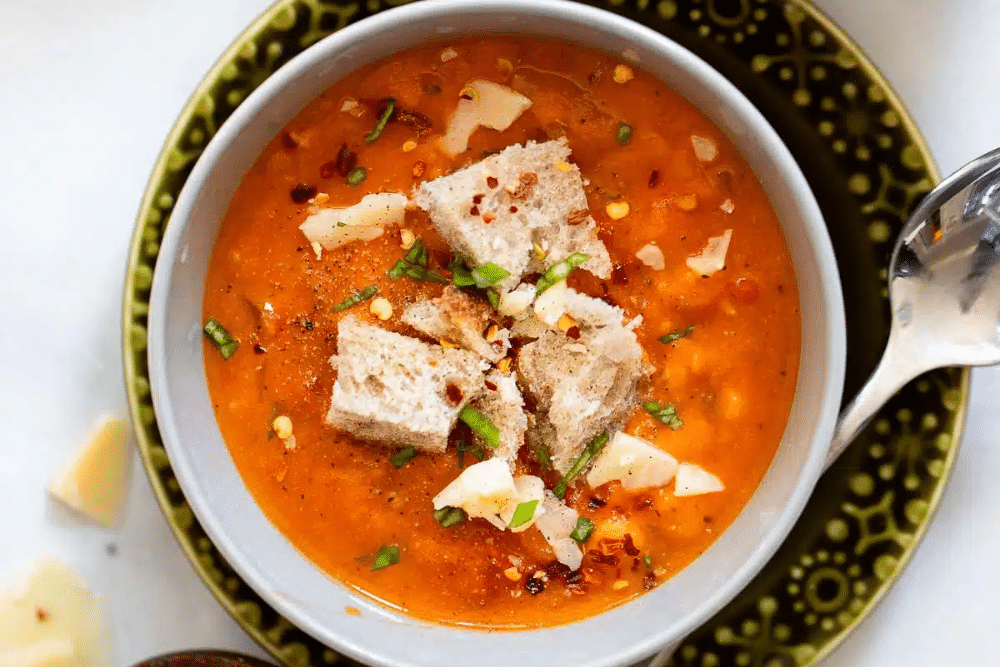 Photo Credit: Get Healthy U
Photo Credit: Get Healthy U
Total Time: 40 minutes
Yield: 8 serving(s)
Ingredients:
- 2 tablespoons extra-virgin olive oil
- 1 medium yellow onion, chopped
- 2 large raw carrots, peeled and chopped
- 3 cloves raw garlic, minced
- 1 (28 oz) can whole peeled tomatoes (San Marzano)
- 4 cups vegetable or chicken broth
- 1 (15 oz) can of garbanzo beans, drained and rinsed
- 10 basil leaves, chopped fine
- 1 ½ cups day old bread, cubed or torn into pieces
- 1/4 teaspoon sea salt and ground black pepper
Instructions:
- Heat the olive oil in a large pot over medium heat. Add the onion and carrots and saute until the onion is translucent. Stir in the garlic and saute for 1 minute.
- In a separate bowl, crush tomatoes by hand. Add them to the pot with salt and pepper. Partially cover and simmer over medium heat for 15 minutes.
- Add the broth, chickpeas, and basil. Bring back to a simmer for another 10 minutes.
- Add the bread cubes; simmer for another 10 minutes until the bread is soft. You can use a potato masher to break down the bread if needed. Add sea salt and black pepper.
- Add ½ of the soup to a blender and puree until smooth (make sure to leave the lid ajar for venting out the steam). Add back to the pot and stir to combine.
- Serve with parmesan cheese, extra olive oil, a dollop of heavy cream (optional), and more fresh basil.
Nutrition Information Per Serving:
- Calories: 175
- Protein: 7 gram(s)
- Fat: 5 gram(s)
- Carbohydrates: 26 gram(s)
- Fiber: 6 gram(s)
- Sugar: 7 gram(s)
More Soup Recipes You’ll Love 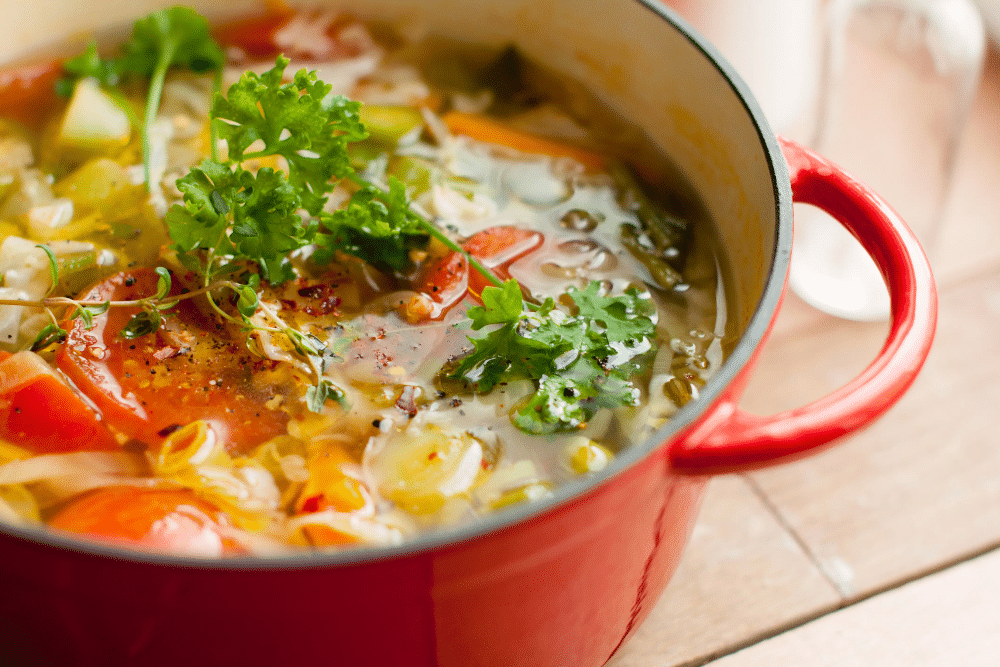 Photo Credit: Get Healthy U
Photo Credit: Get Healthy U
If you are looking for more tomato based soups, here are a few of our favorites: detox vegetable soup, hamburger soup, or this hearty white bean soup. We also rounded up 14 fall soups that everyone will love that are also hearty and delicious.
21 Healthy Quinoa Recipes You’ll Want to Make ASAP 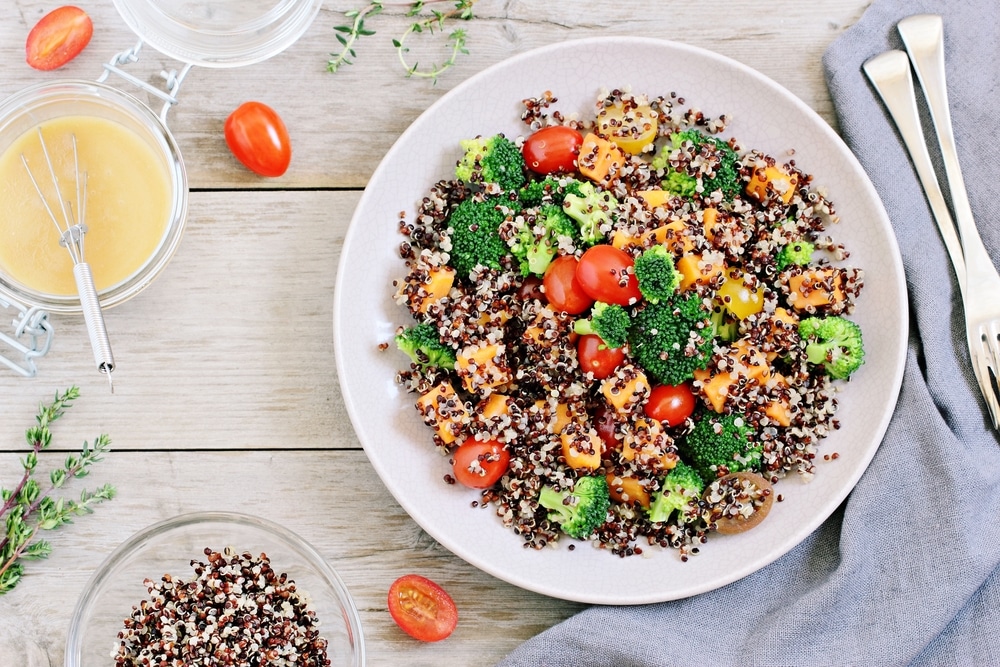 Photo Credit: Shutterstock
Photo Credit: Shutterstock
On the hunt for the best quinoa recipes? We don’t blame you! Quinoa—an edible seed and plant-based protein—is known for being a nutritional powerhouse and easy to incorporate into any meal needing a healthy boost.
Check out our favorite quinoa recipes that are so delicious, you’ll forget how healthy they are!
21 Healthy Quinoa Recipes You’ll Want to Make ASAP
14 Health Benefits of Cucumbers (And a Few Refreshing Recipes) 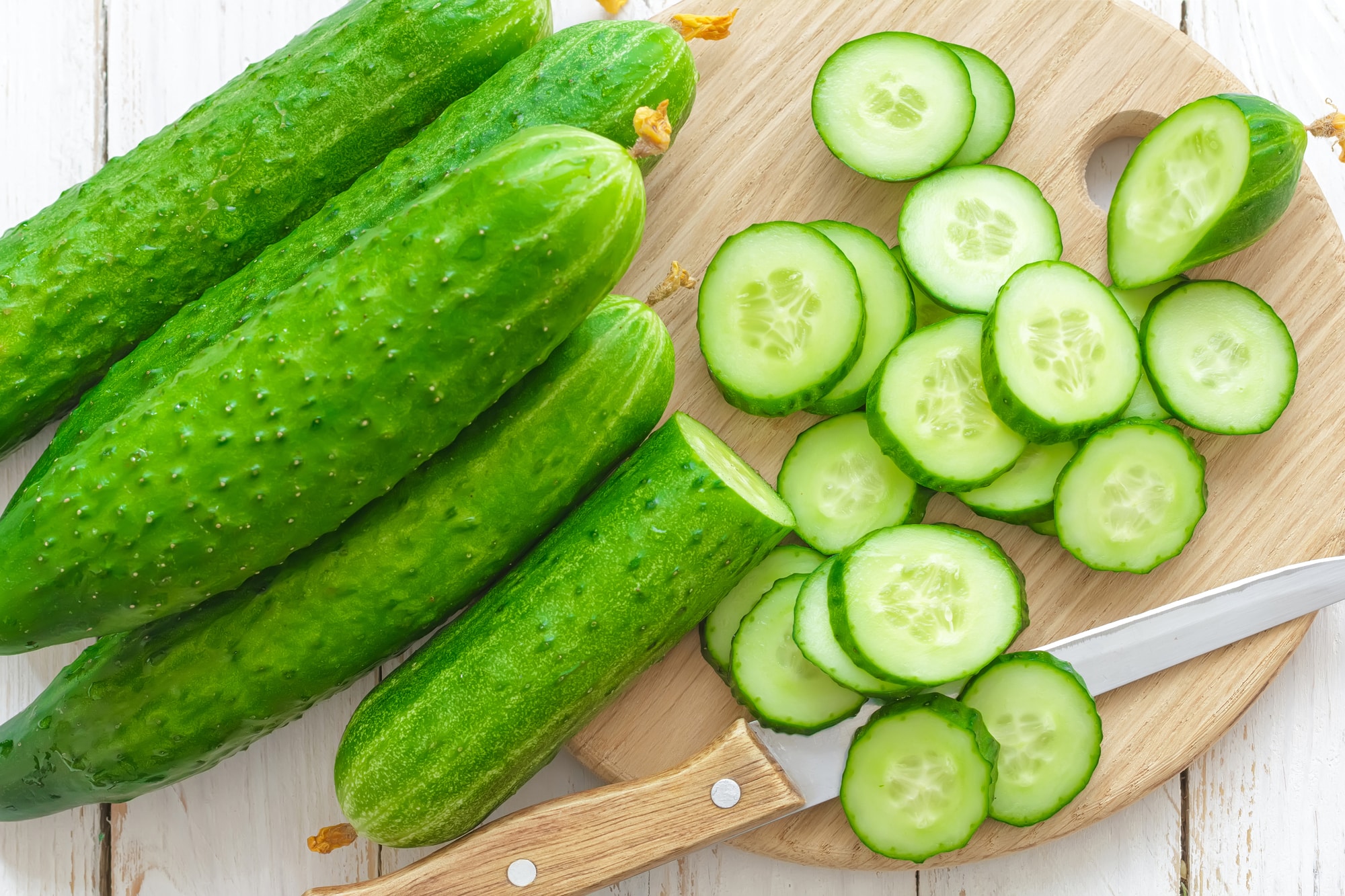 Photo Credit: Depositphotos
Photo Credit: Depositphotos
From healthy skin to improved memory, check out the top 14 health benefits of cucumbers!
And if you’re lucky enough to have a load from your garden or farmers market on hand, you’ll definitely want to check out some of our favorite cucumber recipes, too.
14 Health Benefits of Cucumbers (And a Few Refreshing Recipes)
Highest Rated Low-Calorie Smoothies  Photo Credit: Depositphotos
Photo Credit: Depositphotos
Whether you need an on-the-go breakfast, an energizing afternoon pick-me-up, or a refreshing beverage to cool down on a hot day, all are great reasons to whip up one of these highly-rated smoothies!
Smoothies are naturally packed with nutrients and a great source of fiber since you’re including whole fruits and/or vegetables.
Highest Rated Low-Calorie Smoothies

The Impact of Exercise on Academic Performance: Unveiling the Connection
The physical state of every person is crucial. If you have problems with your health, you cannot live a normal life as they cause multiple complications. For example, schoolers cannot focus on their education as their physical state doesn’t let them study well and follow the pace. Thus, physical education steps up. One is supposed to be healthy physically. It’s necessary to take care of physical activity to remain healthy all the time. When youngsters suffer from various ailments, the best grades will never come regularly.
As a result, many students ask – What writing agency can write an essay for me? They commonly use https://domyessays.com/ because they know how skilled and effective its writers are. Yet, you can simply improve your physical state and thus use its help rarely. This informative guest post explains how physical activity can boost school performance and how an ordinary student can sustain his or her physical condition regularly.
The Positive Effects of Physical Activity
If you undertake physical fitness on a regular basis, you surely sustain your own health. There are more than physical benefits for us. Not all people understand that being in shape also improves our mood and develops our brain. The importance of certified physical education in schools and colleges is huge. We will highlight the main benefits that can help students become more effective learners.
Improvement of Cognition
Not all people know that physical education classes are implemented to develop various kinds of cognitive functions. Multiple studies proved that regular physical exercise can develop our brains in many positive ways. Here are the common cognitive functions one can develop if one is physically active:
- Thinking
- Speaking
- Movements
- Creativity
- Concentration, etc.
You should agree that all these and some other functions are crucial for learning aims. When you devote your physical fitness to cognitive and brain health, you become a more effective learner. You can think clearer and more creatively. You gain a better focus on your tasks and thus rarely make mistakes.
Enhanced Mood
Your health and academic life are tightly related to one another. When you work out physically, and you like that, your brain starts to produce additional levels of such natural hormones as endorphin, dopamine, and serotonin. These are the most famous mood regulators that can improve our mood a lot. When you are in a good mood, you surely study better, get a better focus, desire, etc.
We need to underline one crucial fact. You get those hormones only if you really like what you’re doing. If you go to the gym and you hate that, you will never be in a good mood. It will lower and lead to problems with learning. Select the sport that can bring you pleasure.
Increased Memory Capacity
One of the main benefits of physical activity for learners is the chance to sufficiently expand their memory capacities. Regular workouts help your mind hold more information and remember it for a long time. Thus, the process of learning will be more effective.
Physical Activity Linked to Higher Grades
Undertaking physical fitness on the brain is helpful for academic success. We have already mentioned vital benefits you can enjoy if you work out physically and enjoy that process. These benefits help to focus on what you must do, increase your memory capacity, and make you more energetic and productive. As a result, it helps to perform your duties better and thus earn higher grades when you complete your academic projects.
Tips on How to Boost Your Physical Conditions
Physical activity and physical education are crucial for schoolers. When a youngster is physically active and not exhausted, he/she enjoys vital benefits to earn higher grades. It is necessary to figure out how to boost your physical condition. Here are our recommendations:
- Select the sport you like. First of all, select the kind of sport that suits your talents, preferences, and physical abilities. You are supposed to like it.
- Spend enough time on it. Secondly, schedule your time to work out at least thrice per week.
- Do not overwork. You should not exhaust your body. Even 15 minutes of intensive running or gymnastics may be sufficient for you.
- Consume healthy food. Refuse junk food and consume only natural products.
- Sleep well. A person is supposed to sleep 8-10 hours per day to restore the body.
- Drink enough water. An adult person should drink about 5-8 full glasses of water every day to stay hydrated.
The Bottom Line
Physical activity in the classroom is of enormous importance. Teachers should sustain the physical conditions of their students if they want to keep them healthy and involved in the educational process. There are many benefits that help to improve school performance when you are physically active. Parents are expected to encourage their children, too.
The post How Physical Activity Affects School Performance appeared first on GymGuider.com.
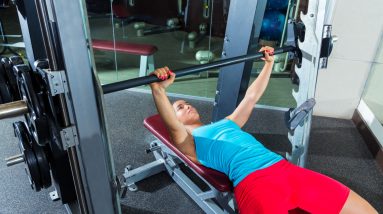
Unleash Your Chest Gains: Mastering the Smith Machine Bench Press
Go into nearly any commercial gym, and you’re likely to find a Smith machine or two in a corner somewhere. More often than not, you might find it deserted in favor of lifting platforms and highly-muscled folks deadlifting 500 pounds. Indeed, the popularity of barbell exercises from the back squat to the clean & jerk has made the humble Smith machine seem obsolete.
But if you’re training alone and aiming to push yourself through failure on the bench press, you might want to reconsider the next time you ignore the oft-neglected apparatus. The Smith machine bench press is an outstanding exercise that offers significant yet untapped upper body gains.
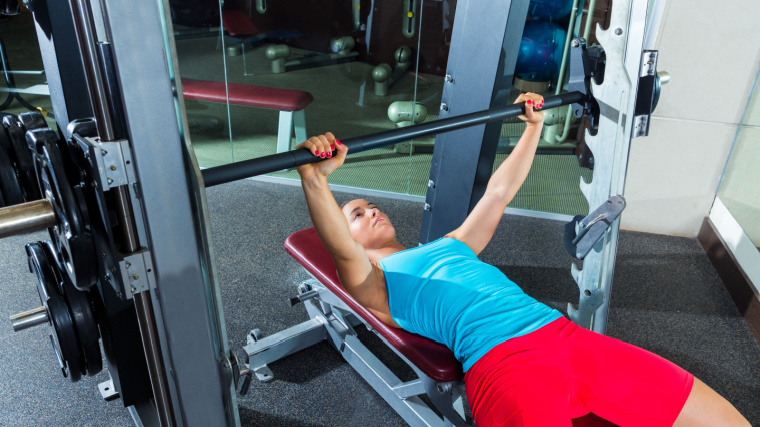 Credit: lunamarina / Shutterstock
Credit: lunamarina / Shutterstock
Countless lifters from years past have made the Smith machine bench press a staple in their routines. Here’s how to do it, why you should try it, some alternatives, and common mistakes to avoid.
- How to Do the Smith Machine Bench Press
- Smith Machine Bench Press Variations
- Smith Machine Bench Press Alternatives
- Benefits of the Smith Machine Bench Press
- Muscles Worked by the Smith Machine Bench Press
- Who Should Do the Smith Machine Bench Press
- Common Smith Machine Bench Press Mistakes
- Frequently Asked Questions
How to Do the Smith Machine Bench Press
The Smith machine bench press is performed similarly to your standard bench press, but there are some unique differences. Here’s how to do it.
Step 1 — Setting Your Base 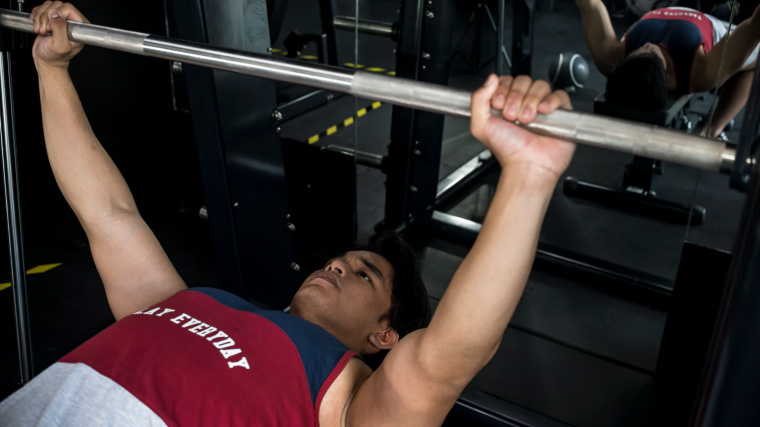 Credit: MDV Edwards / Shutterstock
Credit: MDV Edwards / Shutterstock
Place an adjustable bench in the Smith machine rack. Lie down flat on your back with the bar lined up approximately midway between your collarbone and your belly button. Make sure your feet are flat on the floor and that you’re able to unrack the bar.
Coach’s Tip: Remember to take advantage of the safety bumpers. Line them up at approximately chest height when you’re lying on your back.
Step 2 — Setting Your Grip
Tuck your shoulder blades back and down, engaging your lats with your arms fully extended in front of your body. Grip the bar evenly between each hand, taking care to stay dead center on the bench and the machine. Maintain this grip width with your shoulders back and down for the duration of the set.
Coach’s Tip: If your Smith machine bar doesn’t have any markings, create your own. Try draping a lifting strap in the middle of the bar before you set up.
Step 3 — Arch 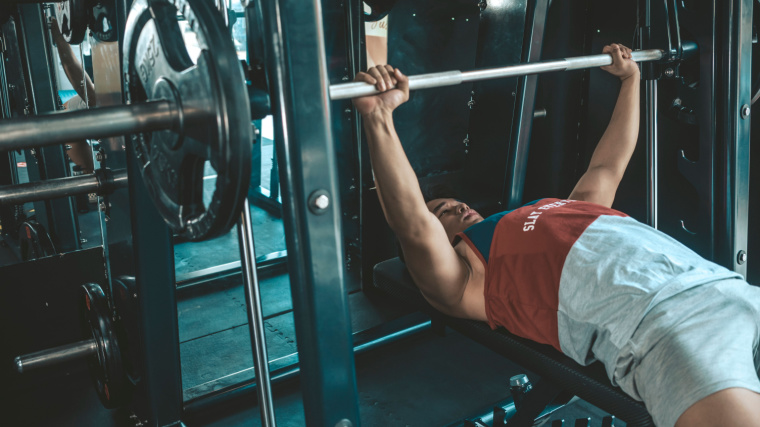 Credit: MDV Edwards / Shutterstock
Credit: MDV Edwards / Shutterstock
Keep your hands on the bar and create a tight natural arch through your thoracic spine. Pull your upper back toward the bar, keeping your lats engaged. Plant your feet flat on the floor where your body has moved to create the arch to maintain this new position.
Coach’s Tip: The bar should now be directly above the highest part of your chest due to your arch.
Step 4 — The Descent 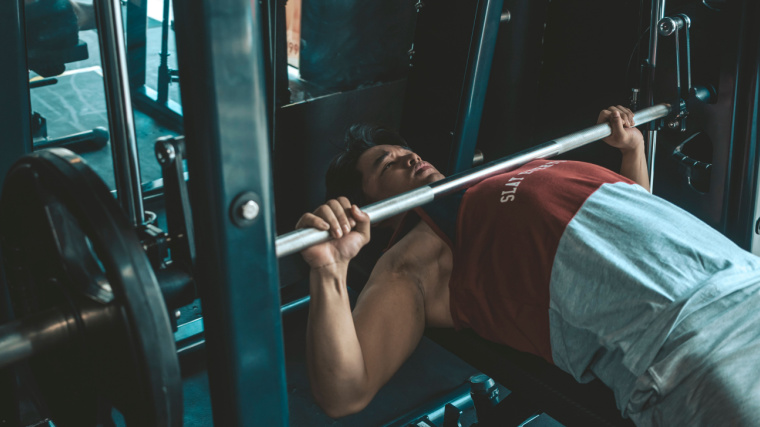 Credit: MDV Edwards / Shutterstock
Credit: MDV Edwards / Shutterstock
Maintain five points of contact — both feet on the floor, your butt, upper back, and head on the bench. Begin a slow and controlled descent through the first repetition, making micro-adjustments to your grip to accommodate your body type and mobility. Stop once the bar reaches your chest or you feel your hands, wrists, elbows, or shoulders starting to lose position.
Coach’s Tip: The Smith machine bench press may not reach your chest on each repetition, and that’s okay! The full range of motion (ROM) is going to be unique to your body.
Step 5 — Press 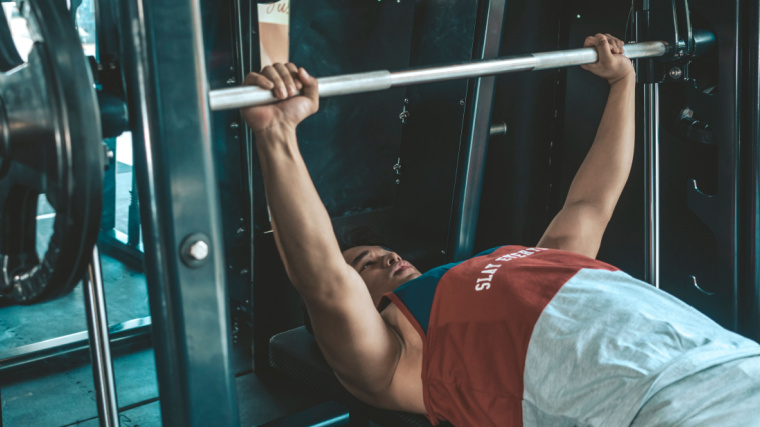 Credit: MDV Edwards / Shutterstock
Credit: MDV Edwards / Shutterstock
With your feet flat on the floor, create huge leg tension by pushing into the ground. Maintain your arch and use this leg drive to stay as tight as possible. Push the bar back to the starting position, making sure to stop before you untuck your shoulders.
Coach’s Tip: Think of performing a quad extension to engage your leg drive.
Smith Machine Bench Press Variations
The Smith machine bench press is a great asset for building your upper body strength. There are also a handful of useful variations to complement your chest workouts further — here they are.
Close-Grip Smith Machine Bench Press
[Read More: 5 Bench Press Programs to Build a Bigger, Stronger Chest]
- Set up your close-grip Smith machine bench press in the same way as your standard setup.
- Adjust your grip an inch or two closer than normal on either side.
- Perform repetitions, emphasizing your triceps by keeping your arms tucked closer to your body.
Paused Smith Machine Bench Press
[Read More: The Best Online Workout Programs For Coaching, Cardio, Value, And More]
- Set up on the Smith machine as you normally would, getting tight before you unrack.
- Lower the bar under control, reaching your chest or the point where you feel you would begin to lose position any lower.
- Pause the bar for one to two seconds before driving it back to the starting position.
Incline Smith Machine Bench Press
[Read More: The Best Back Workout for Men, Women, Strength, and More]
- Set up on the Smith machine and adjust your bench to the first or second inclined position.
- Sit down on the bench. Set your grip by placing your shoulder blades back and down and grabbing the bar.
- Drive your body into the bench by pushing with your legs.
- Descend the bar until it touches your chest or where you feel like you’d lose position. Drive the bar back to the starting position and perform for repetitions.
Smith Machine Bench Press Alternatives
If you’re looking to swap out the Smith machine bench press for some helpful alternatives, look no further than the Smith machine push-up, chest press machine, and Smith machine JM press.
Smith Machine Push-Up
[Read More: Build a Titanic Torso with These Bodybuilding Chest & Back Workouts]
- Set the height of the Smith machine bar to accommodate your strength or repetition goals. The higher the bar, the less load you press.
- Set your shoulders back and down to find your grip, place your hands evenly on the bar, and lean your body weight into the machine.
- Control your descent by slowly bending your elbows. Use the ball of your foot to create a pivot point on the ground. Press yourself back to the starting position once your chest has reached the bar.
Chest Press Machine
[Read More: Get Freakishly Strong With the 5×5 Workout Program]
- Choose the chest press machine of choice: either flat, incline, or decline. Converging machine orientations work best here.
- Adjust the seat so the hand grips align roughly with your armpit height.
- Push yourself into the bench using your feet, grip the handles tightly, and drive out until your elbows are fully extended. Control the descent back to the starting position, and perform for repetitions.
Smith Machine JM Press
[Read More: How to Do the Lat Pulldown for a Wider Back and Better Pull-Ups]
- Set up on the Smith machine similar to how you would do your close-grip bench press.
- Initiate your descent by bending your elbows, but keep your arms tucked close to your body.
- Each repetition will be a combination of a skull crusher and a close-grip bench press. The bar path should be roughly over the top of your nose.
- Lower the bar as you would with a skull crusher, keeping your upper arms in place but bringing your forearms down with the bar toward your face. Maintaining that same position, press the bar up as you would with a close-grip bench press.
- Reset and repeat for reps.
Benefits of the Smith Machine Bench Press
Although the Smith machine bench press gets a lot of negative attention from those would would prefer a barbell, it is extremely beneficial. This lift allows you to perform one of the best upper body exercises using an extremely stable machine. This makes building muscle extremely straightforward — and less risky when you’re training alone.
High Stability
Free weights are a huge asset in the gym. They are easy to use for progressive overload as you increase strength and build muscle over time. However, before a free weight is as effective as it should be, you first need to groove the pattern. Learning to stabilize an exercise is a prerequisite to safely and effectively executing it for your goal.
With the Smith machine, the bench press pattern itself is maintained in a very specific position. The restricted range of motion makes the exercise extremely easy to execute without running into stability plateaus. This higher level of stability makes it a lot easier for you to simply hop in and sprint towards gains.
[Read More: The Ultimate 10-Week Powerbuilding Workout Routine for Mass and Strength]
It should be noted that if you’re a powerlifter, you might want to avoid using this as a training tool since you’ll want to train as specifically as possible for the barbell bench press. That said, if you’re in the offseason and want to train without a spotter — or concern for stability — you’re in luck here.
Upper Body Strength With Less Fear
The Smith machine bench press is a subtle twist on your standard bench press. Both recruit a ton of muscle mass and are some of the most highly loadable upper body exercises in the gym.
The higher you’re able to load an exercise the more top-end strength you’ll unlock. Add in the high stability benefit of the Smith machine and your upper body strength can skyrocket.
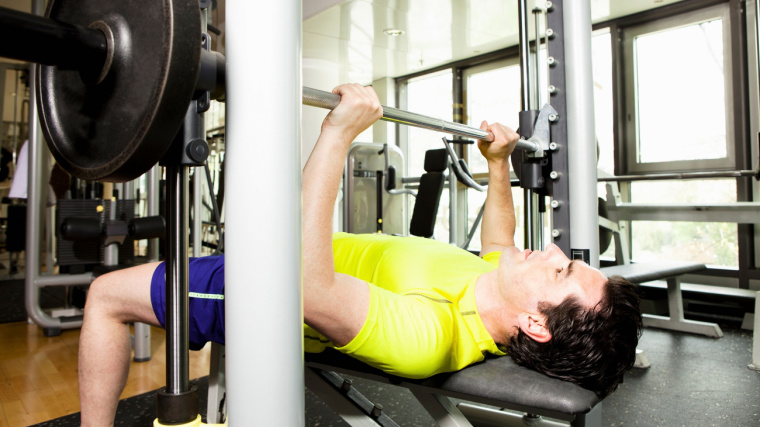 Credit: Image Source Trading Ltd / Shutterstock
Credit: Image Source Trading Ltd / Shutterstock
If you’re training alone, this is a tremendous asset. When you don’t know anyone who can spot you in the gym, the Smith machine comes with built-in safeties. A quick twist of your wrist, if you start failing a rep, can save you from a disaster. This way, you can load up feeling confident that you can safely miss your lift.
Muscle Gain
Similar to building strength, the Smith machine bench press makes it easy to chase major muscle gain. Squeezing out those last few repetitions — the ones that are the hardest and really challenge your progress — is a bit more intimidating on a free bench.
You’re going to need to push yourself, preferably with an experienced spotter, to accomplish progressive overload. The Smith machine helps reinforce your technique, safety, and confidence in training hard enough for muscle gain.
Muscles Worked by the Smith Machine Bench Press
Like any horizontal upper body pressing exercise, the Smith machine bench press primarily targets your chest, triceps, and shoulders.
Chest
The chest is the clear motivator behind nearly every horizontal pressing exercise. Your chest (or pectoralis major) is a fan-shaped muscle that attaches between your collar bone, sternum, and upper ribs to a..
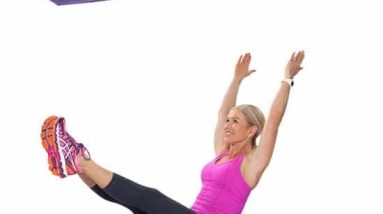
Upgrade Your Ab Workout: 14 Exercises That Crush Crunches
When it comes to flat abs, endless crunches don’t work!
Regardless of your age, the key to a flatter stomach is training your entire core, including exercises that target different areas of your abdominals.
So, if you can’t stand crunches or simply want to mix up your core workout routine, try these 14 effective ab exercises that target all of your abdominal muscles, including your obliques, lower abs, and upper abs.
1. V-Ups 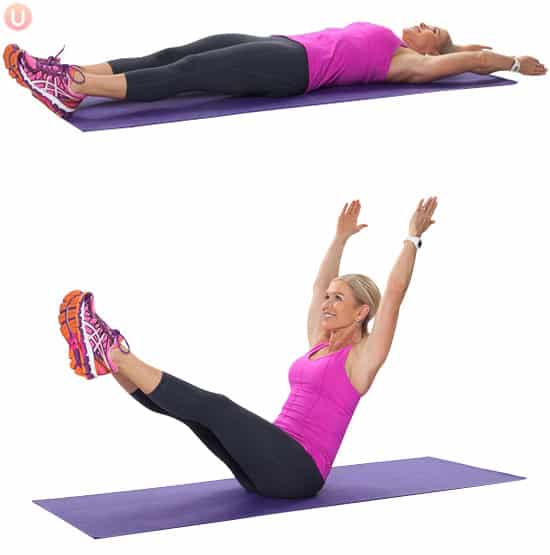 Photo Credit: Get Healthy U
Photo Credit: Get Healthy U
V-ups are one of the best ab workouts because they also develop incredible balance.
- Lie flat on the floor and extend your arms behind your head. Keep your feet together and your toes pointed.
- Keep your legs straight and lift them up as you simultaneously raise your upper body off the floor. Keep your core tight as you reach for your toes with your hands. Slowly lower yourself back down to the starting position.
Targets: transverse abdominus, rectus abdominus
2. Side Plank Dips
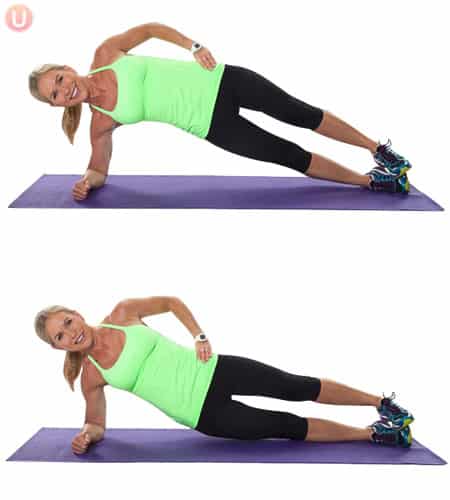 Photo Credit: Get Healthy U
Photo Credit: Get Healthy U
Side plank dips are oblique exercises for anyone looking to develop core strength and enviable side abs.
- Start by laying on your right side with forearm below shoulder, body lifted and legs long, and feet stacked. Keep body straight, abs tight, and place left hand on hip.
- Dip your hips down towards the mat and lift back up using your obliques and core muscles.
Targets: internal obliques, external obliques
3. Side Plank Reach Through
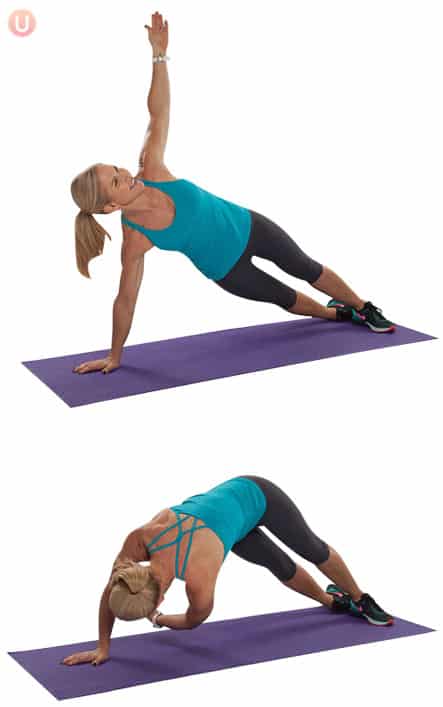 Photo Credit: Get Healthy U
Photo Credit: Get Healthy U
The side plank reach-through is one of the best ab oblique combination movements. You must keep your core engaged the entire time – you’ll be feeling this move!
- Begin in a full side plank position with the right hand below shoulder, left arm reaching high above left shoulder, and legs long. (Modify by placing bottom knee onto mat if needed)
- Tighten the abdominals and slowly scoop the left arm under the body, following with your eyes until you see behind you.
- Slowly reach the left hand back to start position.
- Repeat for the desired number of repetitions and switch sides.
Targets: transverse abdominus, internal obliques, external obliques, rectus abdominus
4. Toe Reach
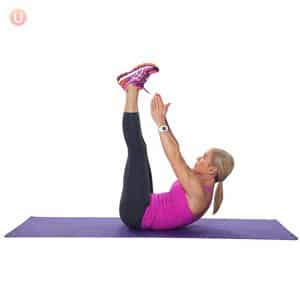 Photo Credit: Get Healthy U
Photo Credit: Get Healthy U
The toe reach is different than the classic crunch you see in most ab workouts. This move focuses more on total core engagement.
- Start on the back with legs long-reaching towards the ceiling.
- Bring the head, neck, and shoulders off the mat and reach arms up towards the feet. Return to the tips of the shoulders and repeat.
Targets: rectus abdominus, transverse abdominus
5. Forearm Plank
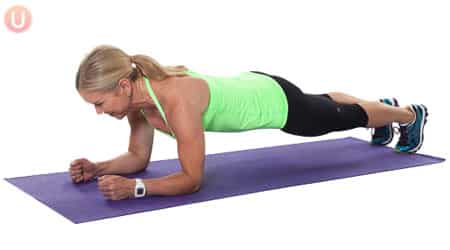 Photo Credit: Get Healthy U
Photo Credit: Get Healthy U
The plank is a staple of most ab workouts because it recruits the entire core.
- Begin lying on the floor with your forearms flat on the floor, making sure that your elbows are aligned directly under your shoulders.
- Engage your core and raise your body up off the floor, keeping your forearms on the floor and your body in a straight line from head to feet. Keep your abdominals engaged, and try not to let your hips rise or drop.
Targets: transverse abdominus
6. Bicycle Crunches
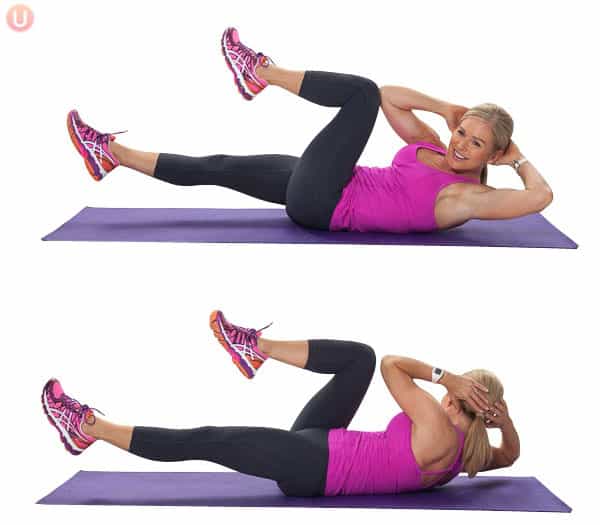 Photo Credit: Get Healthy U
Photo Credit: Get Healthy U
The bicycle crunch builds coordination and a strong core, and is one of the best ab movements out there!
- Start lying on your back with feet off the floor and legs in a tabletop position. Hands are behind the head, and the head, neck, and shoulders are flexed off the mat.
- Bring one knee in and reach the opposite elbow towards it. Repeat on the other side in a crisscross motion working the obliques.
Targets: transverse abdominus, internal obliques, external obliques, rectus abdominus
7. Boat Pose
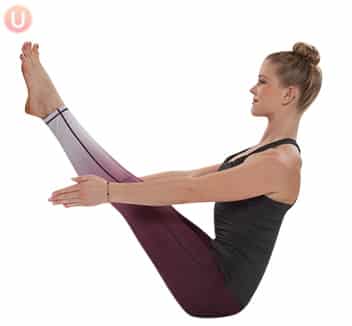 Photo Credit: Get Healthy U
Photo Credit: Get Healthy U
The boat pose is deceptively simple. This move takes incredible core strength and builds core strength. A win-win.
- From a seated position, draw your navel in toward your spine, bracing the abdominals.
- With your hands on the floor behind you, bring your legs up off the floor with your knees bent in front of the chest.
- Keeping abdominals tight, slowly lift hands off the floor and reach them forward and up while lengthening legs upward. Your body will look like a “V” shape. Lengthen your spine as you hold. (If your hamstrings are too tight, you can bend your knees.)
- Keep abdominals tight and breathe. Stay for 30-60 seconds or as long as you can.
Targets: transverse abdominus, rectus abdominus
8. Sweeping Scissors
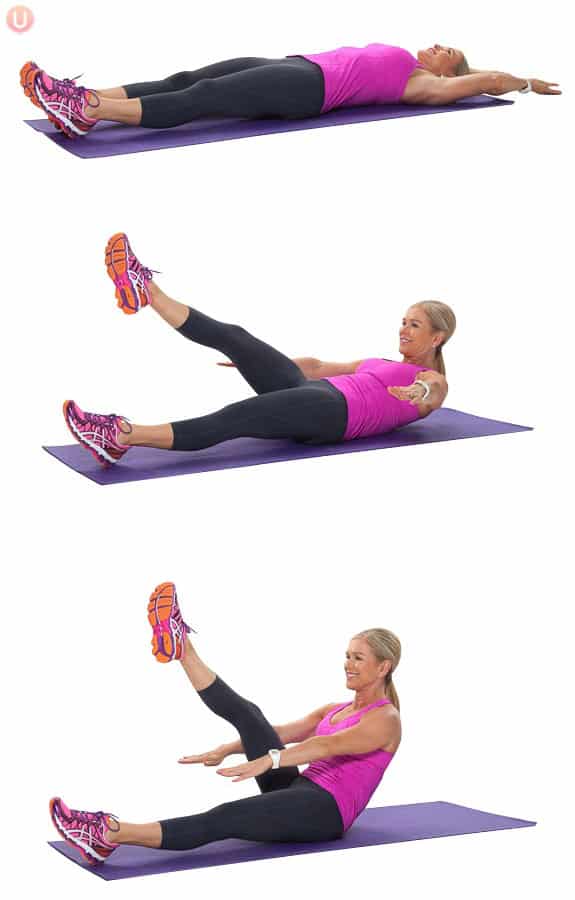 Photo Credit: Get Healthy U
Photo Credit: Get Healthy U
Ready for a challenge?
- Start lying on the mat with arms over your head and legs long.
- Sweep arms out to the sides and bring your head, neck, and shoulders off the mat.
- Reach your arms long and lift one leg up and in towards the chest. Reach your arms forward on the sides of the leg. Roll back to the mat, lowering your leg, and repeat on the other side.
Targets: transverse abdominus, rectus abdominus
9. Side To Side Obliques
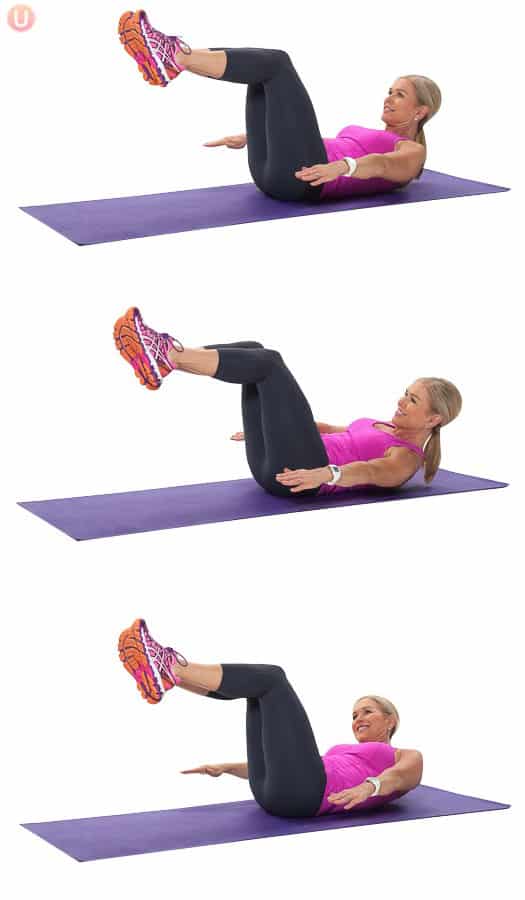 Photo Credit: Get Healthy U
Photo Credit: Get Healthy U
The side-to-side oblique move is one of the best ab exercises for targeting the obliques.
- Lie on the mat and bring your knees into the chest, forming a tabletop position. Bring the head, neck, and shoulder off the mat while coming into a crunch, reaching your arms long at the sides.
- Exhale as you reach your right fingers to the right side in a forward motion, then return to center on the inhale. Exhale and reach left fingers to the left side in the same motion. Switch side to side without lowering onto the mat.
Targets: transverse abdominus, internal obliques, external obliques, rectus abdominus
10. Bend Extend Ab Tuck
 Photo Credit: Get Healthy U
Photo Credit: Get Healthy U
Ab workouts don’t have to be boring. There’s always a new variation to try, just like this bend extends ab tuck.
- Start seated on the mat with arms behind you, hands on the mat, and fingers facing your backside. Sit back on your hands and lift up your feet off the mat keeping the knees bent.
- Keep abs tight and press your legs out long while slightly lowering your back. You should feel your lower abdominals working, then push yourself back up and pull your knees in to return to your starting position.
Targets: transverse abdominus, rectus abdominus
11. Spiderman Abs
 Photo Credit: Get Healthy U
Photo Credit: Get Healthy U
Spiderman abs is a move that hurts so good! Give it a try, and your lower abs will be at attention.
- Start in a plank position with hands on the mat slightly wider than shoulders, legs long behind you, and abdominals and glutes squeezed tight.
- Pull the left knee toward the outside of your left elbow and hold for one count. Return to the starting and repeat on the right side.
Targets: transverse abdominus, external obliques, internal obliques
12. Forearm Star Plank
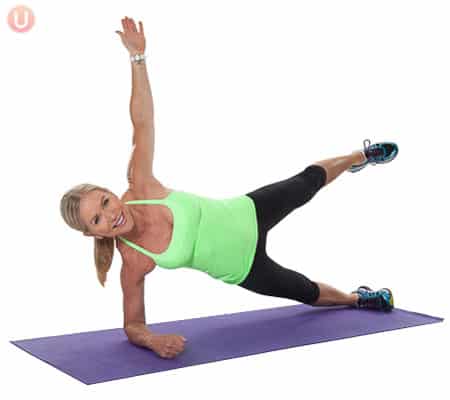 Photo Credit: Get Healthy U
Photo Credit: Get Healthy U
This forearm star plank is a variation on the plank that will help you strengthen your core and those elusive lower abs.
- Begin lying on the right side, forearm on the floor, body lifted, and legs extended long on the mat with feet stacked.
- Tighten the abdominals and lift the left leg and arm up in the air. Hold them straight and keep the body still for the desired amount of time. Switch sides.
Targets: external obliques, internal obliques, transverse abdominus
13. Hip Dips
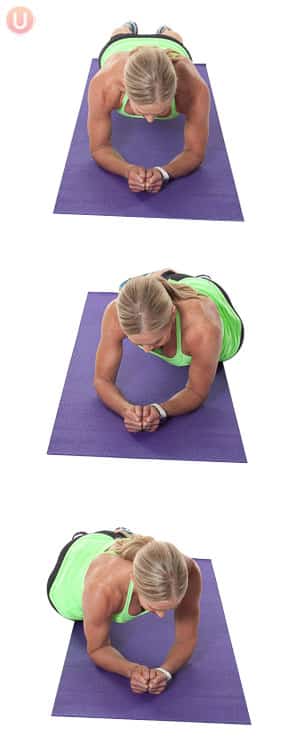 Photo Credit: Get Healthy U
Photo Credit: Get Healthy U
Hip dips really build those oblique muscles!
- Begin in a forearm plank position with your forearms flat on the mat, making sure that your elbows are aligned directly under your shoulders, your core is engaged, and your body is in a straight line from your head to your feet.
- Lower your left hip toward the floor until it almost touches, and then immediately raise back to the center.
- Repeat on the right side.
Target: transverse abdominus, external obliques, internal obliques
14. Double Leg Stretch
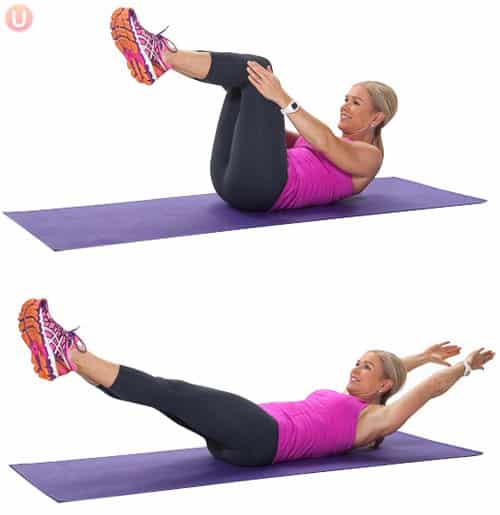 Photo Credit: Get Healthy U
Photo Credit: Get Healthy U
You’ll definitely feel the burn with this one. (Which is a good thing!)
- Start lying on your back with knees bent 90 degrees and arms lengthened alongside the calves. Your lower back should be pressed against the mat with your head, neck, and shoulders flexed up off the mat.
- As you inhale, stretch your arms straight behind your head and legs straight to a diagonal position in front. As you exhale, circle your arms around and back to your legs while drawing your knees back into the 90-degree angle. Repeat for the desired number of reps.
Targets: transverse abdominus, rectus abdominus
Strength Training for Women Over 50: 11 Best Moves 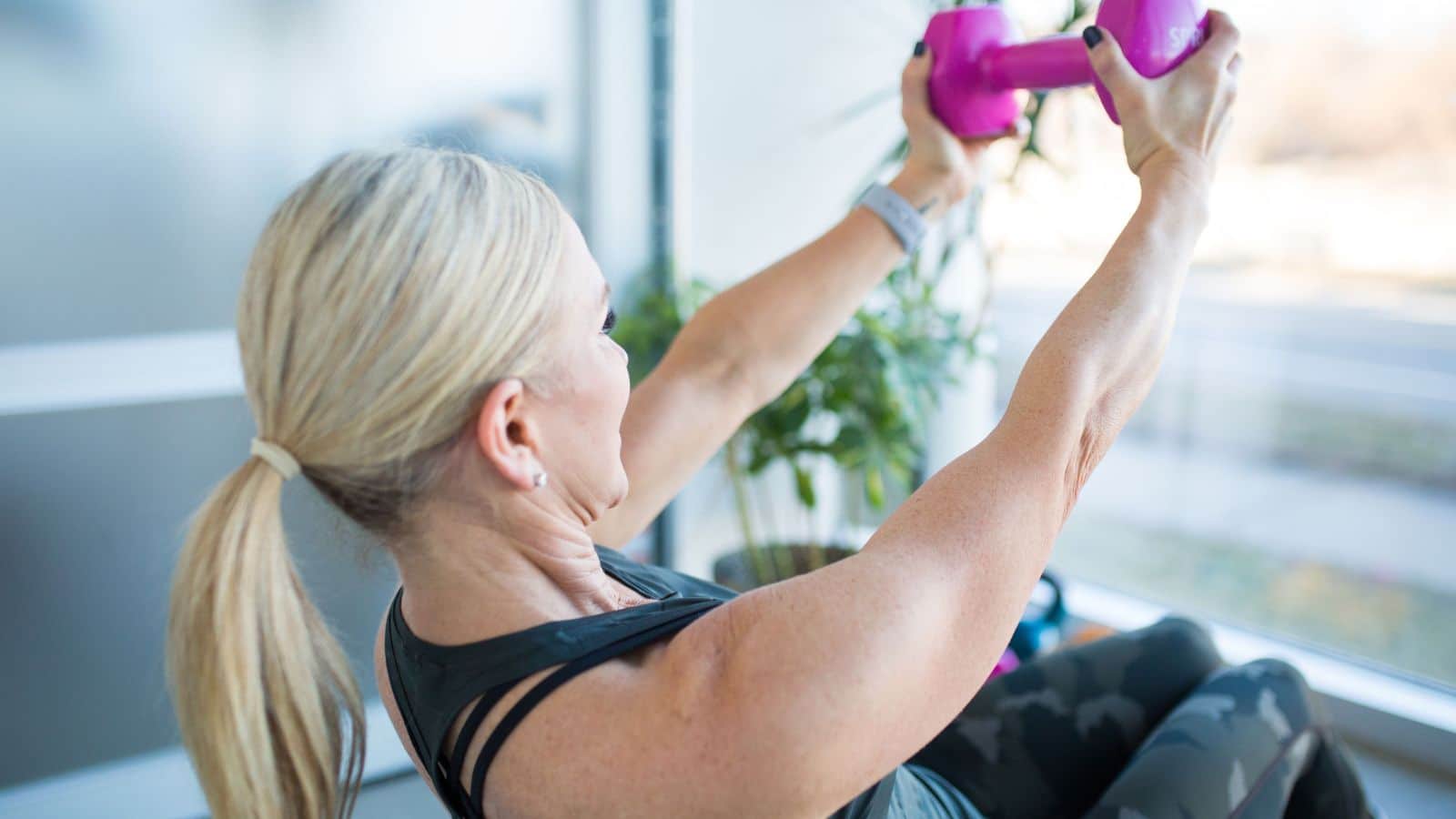 Photo Credit: Get Healthy U
Photo Credit: Get Healthy U
While aging is inevitable, aging well is not.
There are many factors involved in maintaining good physical and mental health as you age, but one of the most important things to consider as you grow older is weight training. Thesestrength training exercises are proven to get results for women over 50.
Strength Training for Women Over 50: 11 Best Moves
3 Walking Workouts For Weight Loss  Photo Credit: Depositphotos
Photo Credit: Depositphotos
If you want to start working out or get back in shape after taking a break from exercise, there’s no better—or more convenient—form of exercise than walking. Walking is low-impact and doable for almost everyone, but if weight loss is your goal, we’re here to tell you that intensity is the key to success.
3 Walking Workouts For Weight Loss
The Best Love Handle Workout 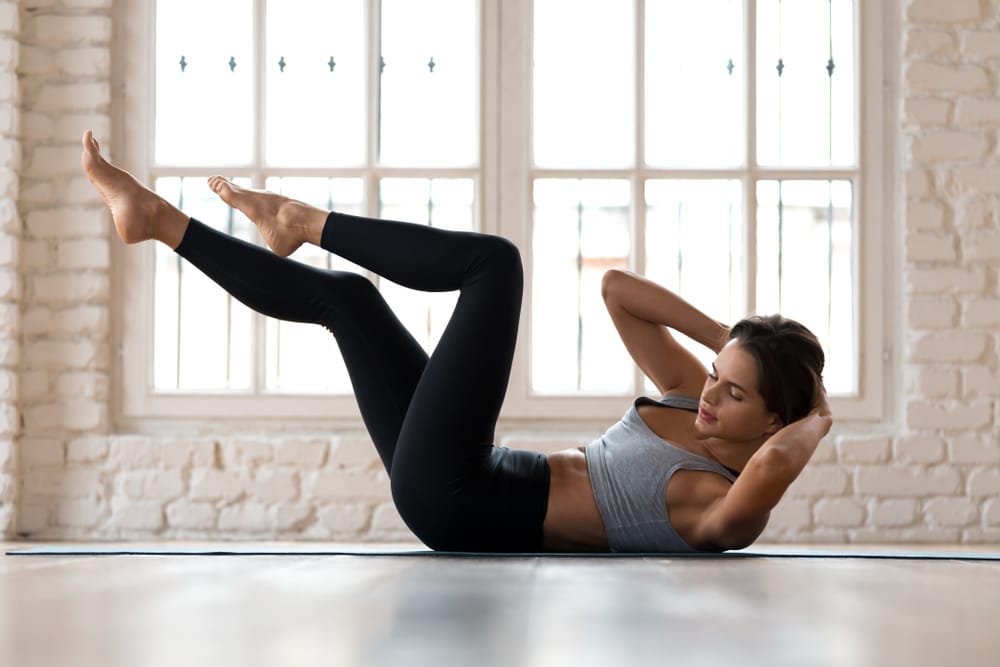 Photo Credit: Shutterstock
Photo Credit: Shutterstock
These five exercises specifically target the love handles and will have you feeling the burn!
Combine this workout with a healthy diet and cardio, and you’ll watch that belly fat “waist” away.
The Best Love Handle Workout

Patricia Smit Dominates the 2023 Netherlands Strongest Woman Competition
The 2023 Netherlands Strongest Woman contest was held on Sept. 17, 2023, in Earnawâld, Netherlands — one day after the 2023 Netherlands Strongest Man U105KG competition. Patricia Smit stood atop the podium in the former contest, while Yoell Blom ranked first in the latter.
Smit scored 61 of a possible 72 points across six events against 11 other strongwoman athletes. Blom raked in 65 of a possible 72 points through the same five events: Deadlift, Bag Toss Medley, Yoke Into Sandbag, Farmer’s Walk, Overhead Ladder, and Atlas Stones.
2023 Netherlands Strongest Woman Results
- Patricia Smit — 61 points
- Mayke Van Wouven — 59 points
- Femke Huisman — 58 points
- Elisa Hessels — 51 points
- Kelly Franssen — 48 points
- Jamie Lee Boudri — 42 points
- Christel Veenstra — 31 points
- Rowena Wehnes — 31 points
- Chelsea Schweiger — 25 points
- Linda Schenk — 24 points
- Yvonne Allards — 21 points
- Femkje Buijs — 17 points
[Related: Mitchell Hooper Explains How Better Cardio Fuels Strength Gains]
2023 Netherlands Strongest Man U105KG Results
- Yoell Blom — 65 points
- Joey Henraath — 57.5 points
- Wim Van De Groep — 53 points
- Christian Van Elderen — 48 points
- Randy Doornekamp — 45 points
- Ruben Van Kreij — 45 points
- John-Mark Bolwerk — 44.5 points
- Jeffrey Laterveer — 38 points
- Tom Van De Burg — 26 points
- Toni Pieters — 23 points
- Alex Schiltmans — 13 points
- Kane Verberkt — 10 points
[Related: How To Do the Alternating Dumbbell Press (+ the Best Variations for Muscle and Strength)]
View this post on InstagramA post shared by Patricia Smit (@miss_silverback)
[Related: How Many Calories Should I Eat Per Day? A Guide for All Your Fitness Goals]
2023 Netherlands Strongest Woman Event Results
Below are the results for each of the five events comprising the 2023 Netherlands Strongest Woman contest:
Deadlift For Reps
Each athlete was tasked to lift 140, 160, 180, 200, and 220 kilograms for as many reps as possible in the 75-second time cap. A single rep at a higher weight trumped any number of reps at a lower weight.
- Patricia Smit — Three of 220 kilograms in 65.59 seconds
- Femke Huisman — One of 220 kilograms in 42.17 seconds
- Mayke Van Wouven — One of 200 kilograms in 71.62 seconds
- Kelly Franssen — One of 200 kilograms in 21.52 seconds
- Yvonne Allards — One of 200 kilograms in 43.93 seconds
- Elisa Hessels — Two of 180 kilograms in 49.37 seconds
- Jamie Lee Boudri — Two of 180 kilograms in 53.58 seconds
- Rowena Wehnes — One of 180 kilograms in 16.02 seconds
- Linda Schenk — Five of 160 kilograms in 66.11 seconds
- Christel Veenstra — Four of 160 kilograms in 72.27 seconds
- Femkje Buijs — Two of 160 kilograms in 30.33 seconds
- Chelsea Schweiger — One of 160 kilograms in 20.52 seconds
Bag Toss Medley
The Bag Toss over a four-meter bar consisted of five implements weighing 10, 12, 14, 16, and 18 kilograms.
- Patricia Smit — Four in 26.06 seconds
- Mayke Van Wouven — Four in 40.71 seconds
- Kelly Franssen — Four in 48.86 seconds
- Femke Huisman — Three in 23.27 seconds
- Elisa Hessels — Three in 25.05 seconds
- Jamie Lee Boudri — Three in 26.8 seconds
- Rowena Wehnes — Three in 59.95 seconds
- Femkje Buijs — Two in 17.77 seconds
- Chelsea Schweiger — One in 5.68 seconds
- Christel Veenstra — One in 11.83 seconds
- Linda Schenk — One in 12.8 seconds
- Yvonne Allards — One in 15.74 seconds
Yoke Into Sandbag
The yoke and sandbag weighed 210 and 80 kilograms, respectively. Each implement had to be carried down a 15-meter course.
- Elisa Hessels — Two in 15.91 seconds
- Patricia Smit — Two in 17.04 seconds
- Mayke Van Wouven — Two in 18.78 seconds
- Femke Huisman — Two in 19.19 seconds
- Jamie Lee Boudri — Two in 21.79 seconds
- Kelly Franssen — Two in 22.09 seconds
- Christel Veenstra — Two in 23.63 seconds
- Chelsea Schweiger — Two in 27.47 seconds
- Linda Schenk — Two in 30 seconds
- Yvonne Allards — Two in 30.62 seconds
- Rowena Wehnes — Two in 34.47 seconds
- Femkje Buijs — Two in 35.57 seconds
Farmer’s Walk
Each athlete carried 60 kilograms down a 20-meter course for distance.
- Christel Veenstra — 93.9 meters
- Chelsea Schweiger — 91.8 meters
- Mayke Van Wouven — 82.2 meters
- Elisa Hessels — 83.5 meters
- Femke Huisman — 80.5 meters
- Jamie Lee Boudri — 80 meters
- Linda Schenk — 70.8 meters
- Patricia Smit — 67.2 meters
- Yvonne Allards — 66.1 meters
- Kelly Franssen — 65.7 meters
- Femkje Buijs — 60 meters
- Rowena Wehnes — 59.8 meters
Overhead Ladder
Within the 75-second time cap, each athlete attempted to lift 40, 50, 60, 70, or 80 kilograms. One rep at a higher weight outranked any number of reps at a lower weight.
- Femke Huisman — Four of 80 kilograms in 62.8 seconds
- Rowena Wehnes — Three of 80 kilograms in 63.9 seconds
- Mayke Van Wouven — Three of 80 kilograms in 67.14 seconds
- Patricia Smit — Three of 80 kilograms in 74.85 seconds
- Kelly Franssen — Two of 80 kilograms in 69.8 seconds
- Jamie Lee Boudri — Two of 80 kilograms in 70.42 seconds
- Elisa Hessels — Two of 70 kilograms in 64.02 seconds
- Femkje Buijs — One of 70 kilograms in 30.67 seconds
- Linda Schenk — One of 70 kilograms in 35.24 seconds
- Yvonne Allards — Four of 60 kilograms in 64.3 seconds
- Christel Veenstra — Four of 60 kilograms in 72.2 seconds
- Chelsea Schweiger — Three of 60 kilograms in 61.61 seconds
Atlas Stones
The six Atlas Stones weighed 50, 80, 90, 100, 110, and 120 kilograms.
- Patricia Smit — Six in 41.68 seconds
- Mayke Van Wouven — Six in 52.75 seconds
- Kelly Franssen — Five in 29.83 seconds
- Femke Huisman — Five in 40.09 seconds
- Elisa Hessels — Five in 54.08 seconds
- Jamie Lee Boudri — Four in 28.65 seconds
- Rowena Wehnes — Four in 30.74 seconds
- Christel Veenstra — Four in 36.52 seconds
- Linda Schenk — Four in 42.36 seconds
- Chelsea Schweiger — Four in 45.58 seconds
- Femkje Buijs — Three in 33.11 seconds
- Yvonne Allards — Three in 81.02 seconds
[Related: Develop a Better Mind-Muscle Connection With These Quick Tips]
View this post on InstagramA post shared by Yoëll Blom | krachtcoach (@yoellblom)
[Related: How to Make Homemade Meal Replacement Shakes to Fuel Your Training Goals]
2023 Netherlands Strongest Man U105KG Event Results
Below are the results for each of the five events comprising the 2023 Netherlands Strongest Man U105KG contest:
Deadlift For Reps
The available weights were 200, 220, 240, 260, and 280 kilograms for as many reps as possible in the 75-second time cap. A single rep at a higher weight outranked any number of reps at a lower weight.
- Tom Van De Burg — Five of 280 kilograms in 65 seconds
- Yoell Blom — Five of 280 kilograms in 74 seconds
- Ruben Van Kreij — Three of 280 kilograms in 60 seconds
- John-Mark Bolwerk — Three of 280 kilograms in 64 seconds
- Wim Van De Groep — Three of 280 kilograms in 70 seconds
- Joey Henraath — Two of 280 in 45 seconds
- Jeffrey Laterveer — One of 280 kilograms in 47 seconds
- Randy Doornekamp — Three of 260 kilograms in 63 seconds
- Christian Van Elderen —Two of 260 kilograms in 70 seconds
- Toni Pieters — Two of 260 kilograms in 75 seconds
- Alex Schiltmans — One of 260 kilograms in 36 seconds
- Kane Verberkt — One of 240 kilograms in 14 seconds
Bag Toss Medley
The Bag Toss over a four-meter bar consisted of five implements weighing 18, 20, 22, 24, and 26 kilograms.
- Randy Doornekamp — Five in 17.62 seconds
- Yoell Blom — Five in 21.56 seconds
- Christian Van Elderen — Five in 22.9 seconds
- Ruben Van Kreij — Five in 25 seconds
- Joey Henraath — Five in 30.07 seconds
- Wim Van De Groep — Five in 46.97 seconds
- Jeffrey Laterveer — Four in 14 seconds
- John-Mark Bolwerk — Four in 22 seconds
- Toni Pieters — Four in 42 seconds
- Tom Van De Burg — Three in 38 seconds
- Kane Verberkt — Two in 11 seconds
- Alex Schiltmans — Two in 12 seconds
Yoke Into Sandbag
The yoke and sandbag weighed 340 and 120 kilograms, respectively, to be carried down a 15-meter course.
- Joey Henraath — 19.97 seconds (T-first)
- John-Mark Bolwerk — 19.97 seconds (T-first)
- Wim Van De Groep — 21.78 seconds
- Jeffrey Laterveer — 22.94 seconds
- Yoell Blom — 23.63 seconds
- Christian Van Elderen — 24.15 seconds
- Ruben Van Kreij — 25.4 seconds
- Randy Doornekamp — 36.47 seconds
- Tom Van De Burg — 39.65 seconds
- Toni Pieters — 42.66 seconds
- Kane Verberkt — 48.01 seconds
- Alex Schiltmans — 50.69 seconds
Farmer’s Walk
This walk for distance along a 20-meter course involved 110 kilograms.
- Wim Van De Groep — 64.3 meters
- Yoell Blom — 60 meters
- Joey Henraath — 59.1 meters
- Christian Van Elderen — 54.5 meters
- Randy Doornekamp — 52.1 meters
- John-Mark Bolwerk — 49.75 meters
- Jeffrey Laterveer — 41.35 meters
- Ruben Van Kreij — 40 meters
- Kane Verberkt — 33 meters
- Alex Schiltmans — 24.1 meters
- Tom Van De Burg — 23.3 meters
- Toni Pieters — 23.1 meters
Overhead Ladder
The weights were 80, 90, 100, 110, and 120 kilograms. A single rep at a higher weight outranked any number of reps at a lower weight.
- Yoell Blom — Three of 120 kilograms in 58.27 seconds
- Joey Henraath — Three of 120 kilograms in 60.62 seconds
- Randy Doornekamp —Three of 120 kilograms in 65.37 seconds
- Christian Van Elderen — Three of 120 kilograms in 70.78 seconds
- Ruben Van Kreij — Three of 120 kilograms in 73.37 seconds
- Jeffrey Laterveer — Two of 120 kilograms in 60.18 seconds
- Toni Pieters — Two of 120 kilograms in 65.75 seconds
- Wim Van De Groep — One of 120 kilograms in 39.83 seconds
- John-Mark Bolwerk — One of 110 kilograms in 35.11 seconds
- Tom Van De Burg — One of 110 kilograms in 39.61 seconds
- Alex Schiltmans — One of 110 kilograms in 47.26 seconds
- Kane Verberkt — One of 100 kilograms in 23.46 seconds
Atlas Stones
Within 90 seconds to a 1.15-meter platform, each athlete loaded six stones weighing 130, 140, 150, 160, 170, and 180 kilograms in the fastest time possible.
- Yoell Blom — Six in 79.53 seconds
- Wim Van De Groep — Five in 32.54 seconds
- Joey Henraath — Five in 61.18 seconds
- Christian Van Elderen — Five in 88.28 seconds
- John-Mark Bolwerk — Four in 32.52 seconds
- Ruben Van Kreij — Four in 55.71 seconds
- Toni Pieters — Three in 58.86 seconds
- Randy Doornekamp — Two in 14.74 seconds
- Jeffrey Laterveer — Two in 15.85 seconds
- Alex Schiltmans — Two in 18.65 seconds
- Tom Van De Burg — Two in 23.65 seconds
- Kane Verberkt — One in 18.05 seconds
More Strongman Content
- 2023 England’s Strongest Man and Strongest Woman Results
- Gavin McNamee Wins 2023 UK’s Strongest Man U90KG
- Brian Shaw Suffered a Torn Pec at the 2023 Shaw Classic
Featured image: @miss_silverback on Instagram
The post 2023 Netherlands Strongest Woman Results — Patricia Smit Victorious appeared first on BarBend.

10 Compelling Reasons to Embrace a Raw Food Lifestyle
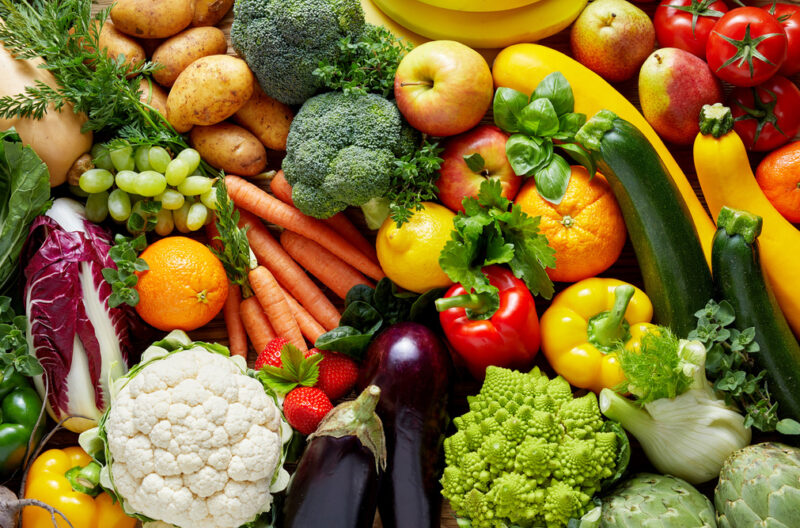
The most important reason to eat raw is to benefit from the enzymes. Enzymes can rightfully be called the fountain of youth. They are necessary for breaking down and absorbing the food that we eat. Enzymes are essential for the body’s vitality. Simply put, we are not what we eat we are what we digest. All food that we eat must be broken down. Our cells cannot absorb large structures. Protein must be broken down into amino acids, complex carbohydrates into simple sugars and fats into fatty acids. This is a huge job for our bodies and where most health problems begin. Without enzymes digestion can become very compromised. When we cook our food, we lose the enzymes. Heating food to over 118 degrees Fahrenheit destroys the enzymes present in the raw ingredients. Food that contains few or no enzymes depletes your body of its own natural resources, accelerates the ageing process, and can cause illness due to a struggling digestion system.
If possible, try to eat fruits and vegetables that are organic. Crops today are heavily sprayed with herbicides and pesticides and this can be very toxic to the gut microbiome. If you are unable to purchase organic food, try using a vegetable and fruit cleanser, available in most health food stores. This would help to remove bacteria and pesticide residue. Scrub root vegetables with a stiff brush that you use just for your food. There is a list well documented from the EWG called the “CLEAN 15 AND DIRTY DOZEN” that you could take a look at for what is recommended to go strictly organic and where you can be more flexible. https://eatrealamerica.com/wp-content/uploads/2019/03/EWG-Clean-15-and-Dirty-Dozen-PDF.pdf
Try not to go overboard on spinach, Swiss chard, and kale. These foods contain oxalic acid, which inhibits the absorption of the essential mineral’s calcium, magnesium, and zinc. This does not mean that you must avoid them completely as they do contain important nutrients. Adding these greens to your salads a couple of times a week would be fine.
Other benefits from eating a raw food diet include experiencing an improvement in skin and increased energy. It is important to stay fully hydrated if you want nice skin and the fact that fruits and vegetables contain a lot of water allows you to do just that. In fact, the quality of the water in organic fruits and vegetables is much safer and higher than in tap water as there are no chemicals, only nutrients. If you eat raw food, you will notice that you are less thirsty and therefore can get away with drinking less water.
If you are looking to lose some weight, eating rawer will certainly help you do just that. Raw foods, being unprocessed, there is no need to worry about extra fats, sugars, and additives which are the main contributors to weight gain. Added to this, the quantity of fiber that you get eating raw as opposed to cooked will increase elimination resulting in less bloat and constipation.
To conclude, I am not suggesting that we all gravitate to a completely raw diet. But it would make a big difference if we all focused a little bit more on what we are fueling our body with. Perhaps just try to include more fruit and salads each day. When you are eating a cooked meal adding some leafy greens for added enzymes can make all the difference on how you digest that meal.
The post reasons to go raw appeared first on Total Gym Pulse.
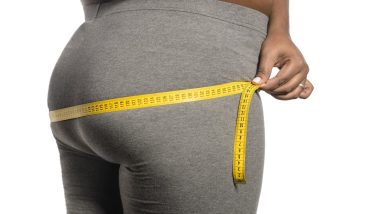
The Ultimate Guide to Shedding Hip Fat: Expert Tips and Tricks
How to Reduce Hip Fat: A Comprehensive Guide Blog – HealthifyMe Blog – HealthifyMe – The definitive guide to weight loss, fitness and living a healthier life.
Excess hip fat can be a source of frustration and concern for many individuals. Whether it’s for health reasons or simply to boost self-confidence, the quest to reduce hip fat is a common goal. If you’ve found yourself searching for ways to trim down your hips, you’re not alone. In this comprehensive guide, we will explore effective strategies, tips, and techniques to help you achieve your goal of reducing hip fat.
Understanding the dynamics of hip fat, its impact on your overall health, and the factors contributing to its accumulation is the first step in your journey. From there, we will delve into practical steps you can take, including adopting healthy eating habits, incorporating targeted exercises, making lifestyle changes, and even considering supplements to aid your efforts. Tracking your progress and staying motivated are also crucial aspects of this journey.
By the end of this guide, you’ll have a well-rounded understanding of how to reduce hip fat and the tools necessary to embark on this transformative journey towards a healthier, more confident you. So, let’s dive in and discover the path to achieving those desired results and embracing life with reduced hip fat.
Types of Hip Fat
When it comes to addressing hip fat, it’s crucial to understand the two primary types of fat that can accumulate in this area: subcutaneous fat and visceral fat.
Subcutaneous Fat
Subcutaneous fat is the fat that lies just beneath the skin’s surface in the hip and thigh area.
It is the type of fat that you can typically pinch and feel.
While subcutaneous fat is less harmful to your health compared to visceral fat, excessive accumulation can still affect your appearance and self-confidence.
Subcutaneous fat serves as a source of energy and helps regulate body temperature.
Visceral Fat
Visceral fat, also known as intra-abdominal or organ fat, is the fat that surrounds your internal organs, including those in the abdominal and hip regions.
It is not visible from the outside, making it different from subcutaneous fat.
High levels of visceral fat are associated with increased health risks, including heart disease, type 2 diabetes, and certain cancers.
Visceral fat can release inflammatory substances that can negatively impact your overall health.
Factors Contributing to Hip Fat Accumulation
To effectively reduce hip fat, it’s essential to recognize the various factors that can contribute to its accumulation. Understanding these contributing factors can help you make informed choices and tailor your approach to target hip fat effectively. Here are the key factors:
Dietary Habits
High-Calorie Intake: Consuming more calories than your body needs can lead to fat storage, including in the hip area. A diet rich in high-calorie, processed, and sugary foods can contribute to hip fat accumulation.
Unhealthy Fats: Diets high in saturated and trans fats can promote fat storage in the hip region. Replacing these fats with healthier options like monounsaturated and polyunsaturated fats can be beneficial.
Physical Activity Levels
Sedentary Lifestyle: Lack of regular physical activity and prolonged periods of sitting can lead to the storage of excess fat in the hips and other areas. Incorporating more movement into your daily routine is crucial for burning calories and reducing hip fat.
Lack of Strength Training: Focusing solely on cardio exercises without incorporating strength training can limit your ability to tone and shape your hip area. Resistance exercises can help build muscle and boost metabolism.
Hormonal Changes
Menopause: Women going through menopause often experience hormonal changes that can lead to increased fat storage, especially in the hips and abdomen. Hormone replacement therapy and a balanced diet can help manage this.
Imbalanced Hormones: Hormonal imbalances, such as insulin resistance or thyroid disorders, can contribute to fat accumulation around the hips. Consult with a healthcare provider to address these issues.
Stress
Chronic stress triggers the release of cortisol, a hormone associated with fat storage, particularly around the abdominal and hip areas. Stress management techniques, such as meditation and yoga, can help reduce cortisol levels.
Lack of Sleep
Poor sleep patterns and inadequate rest can disrupt hormones related to appetite and metabolism, potentially contributing to hip fat gain. Aim for 7-9 hours of quality sleep each night.
Summary
Effectively reducing hip fat necessitates a thorough understanding of the contributing factors. These factors include dietary habits like high-calorie intake and unhealthy fats, which can promote fat storage in the hip area. Sedentary lifestyles and a lack of strength training can hinder fat reduction, while hormonal changes, such as those during menopause or due to imbalanced hormones, may lead to increased hip fat. Chronic stress and insufficient sleep can further exacerbate the issue by triggering cortisol release and disrupting appetite-regulating hormones. Addressing these factors through dietary adjustments, physical activity, stress management, and adequate sleep is essential for effective hip fat reduction.
Effective Exercises to Reduce Hip Fat
Now that we’ve gained an understanding of the factors contributing to hip fat accumulation, it’s time to explore effective exercises that can help you trim and tone your hips. Incorporating targeted workouts into your fitness routine is key to achieving your goal of reducing hip fat. Below are some exercises that focus on the hip area:
A. Squats
How to Perform: Stand with your feet shoulder-width apart. Lower your body by bending your knees and hips, as if you’re sitting back into an imaginary chair. Keep your back straight and chest up. Push through your heels to return to the starting position.
Benefits: Squats target the muscles in your hips, thighs, and buttocks, helping to shape and tone these areas while burning calories.
B. Lunges
How to Perform: Take a step forward with one leg and lower your body until both knees are bent at a 90-degree angle. Keep your front knee directly above your ankle and your back knee hovering just above the ground. Push off the front foot to return to the starting position.
Benefits: Lunges work the hip muscles, thighs, and glutes, contributing to hip fat reduction and lower body strength.
C. Hip Raises (Glute Bridges)
How to Perform: Lie on your back with your knees bent and feet flat on the floor, hip-width apart. Lift your hips off the ground by squeezing your glutes and pushing through your heels. Hold for a moment at the top, then lower your hips back down.
Benefits: Hip raises target the glutes and hamstrings, helping to lift and shape the buttocks while also engaging the hip muscles.
D. Leg Lifts
How to Perform: Lie on your side with your legs straight. Lift your top leg as high as you can without bending it at the knee, then lower it back down.
Benefits: Leg lifts focus on the outer hip muscles and can help tone and sculpt this area.
E. Cardiovascular Exercises
Running, Walking, Cycling: Engaging in cardio workouts helps burn overall body fat, which includes fat stored in the hips. Aim for at least 150 minutes of moderate-intensity cardio exercise per week.
Lifestyle Changes to Reduce Hip Fat
Achieving and maintaining a leaner hip area requires more than just exercise; it involves adopting healthier lifestyle habits that support your fat reduction goals. In this section, we’ll explore key lifestyle changes you can make to effectively reduce hip fat and improve your overall well-being:
A. Stress Management
Incorporate mindfulness techniques, such as meditation and deep breathing exercises, into your daily routine to reduce stress levels. Lowering stress can help prevent excess cortisol production, which can lead to hip fat accumulation.
B. Adequate Sleep
Aim for 7-9 hours of quality sleep each night by maintaining a consistent sleep schedule. Quality sleep supports hormonal balance, which is essential for weight management.
C. Reduce Sedentary Behavior
Avoid prolonged sitting or inactivity. Take short breaks to stand, stretch, or walk around, especially if you have a sedentary job. Consider a standing desk or a stability ball chair to engage your core and hip muscles while working.
D. Hydration
Drinking an adequate amount of water throughout the day helps maintain metabolism and supports overall health. Sometimes, thirst can be mistaken for hunger, leading to unnecessary snacking.
E. Healthy Eating Habits
Focus on a diet rich in fruits, vegetables, lean proteins, and whole grains. Avoid or limit processed foods, sugary drinks, and excessive saturated fats. Be mindful of portion sizes to avoid overeating. Use smaller plates and practice intuitive eating, listening to your body’s hunger and fullness cues.
F. Limit Alcohol Consumption
Excessive alcohol consumption can contribute to hip fat accumulation due to its high-calorie content and impact on metabolism. Limit your alcohol intake or opt for healthier beverage choices.
G. Caffeine Intake
While caffeine can boost metabolism, excessive consumption may lead to increased stress and disrupted sleep. Consume caffeine in moderation and be mindful of its effects on your body.
H. Regular Physical Activity
Maintain a regular exercise routine that includes both cardiovascular workouts and strength training exercises to burn calories and tone your hip area. Mix up your workouts to prevent plateaus and keep your body challenged.
Summary
Effectively reducing hip fat necessitates a thorough understanding of the contributing factors. These factors include dietary habits like high-calorie intake and unhealthy fats, which can promote fat storage in the hip area. Sedentary lifestyles and a lack of strength training can hinder fat reduction, while hormonal changes, such as those during menopause or due to imbalanced hormones, may lead to increased hip fat. Chronic stress and insufficient sleep can further exacerbate the issue by triggering cortisol release and disrupting appetite-regulating hormones. Addressing these factors through dietary adjustments, physical activity, stress management, and adequate sleep is essential for effective hip fat reduction.
Supplementing Your Efforts to Reduce Hip Fat
While a balanced diet and regular exercise are the cornerstones of any successful hip fat reduction plan, some individuals may consider supplements to complement their efforts. It’s important to note that supplements should never be a replacement for a healthy lifestyle, and their effectiveness can vary from person to person. Before incorporating any supplements into your routine, consult with a healthcare professional to ensure they are safe and suitable for you. Here are some supplements that are commonly associated with hip fat reduction
A. Omega-3 Fatty Acids
Sources: Omega-3 supplements are often derived from fish oil, krill oil, or algae.
Benefits: Omega-3 fatty acids have anti-inflammatory properties and may help with weight loss and reducing visceral fat, including that around the hips.
B. Green Tea Extract
Sources: Green tea extract supplements contain concentrated amounts of beneficial compounds found in green tea.
Benefits: Green tea extract is believed to boost metabolism and promote fat oxidation, potentially aiding in hip fat reduction.
C. Conjugated Linoleic Acid (CLA)
Sources: CLA is found naturally in meat and dairy products, but supplements provide a concentrated form.
Benefits: CLA supplements have been studied for their potential to reduce body fat, including in the hip area, and may support lean muscle mass.
D. Protein Supplements
Sources: Protein supplements can include whey protein, casein protein, or plant-based protein sources.
Benefits: Adequate protein intake is crucial for muscle maintenance and repair. Protein supplements can help you meet your protein needs, especially if you have difficulty doing so through diet alone.
E. Fiber Supplements
Sources: Fiber supplements contain soluble or insoluble fibre, which can aid in digestion and promote a feeling of fullness.
Benefits: Fiber supplements may help control appetite and reduce overall calorie intake, indirectly supporting hip fat reduction.
Tracking Progress in Your Hip Fat Reduction Journey
Measuring and monitoring your progress is a crucial aspect of achieving your goal of reducing hip fat. By tracking your efforts, you can stay motivated, identify what’s working, and make necessary adjustments to your plan. Here are some effective ways to track your progress:
A. Body Measurements
Regularly measure your hip circumference using a measuring tape. Record these measurements in a journal or on a tracking app to see changes over time.
Take progress photos from multiple angles to visually track changes in your hip area. Compare these photos regularly to assess improvements.
B. Scale Weight
While scale weight alone is not a perfect measure of hip fat reduction, it can provide valuable insights. Weigh yourself consistently at the same time of day and under the same conditions (e.g., after waking up and using the restroom).
Look for trends in weight changes over weeks or months rather than daily fluctuations.
C. Fitness Progress
Keep a fitness journal to log your exercise routines, including the type, duration, and intensity of workouts.
Track improvements in your strength and endurance, which can indicate progress in muscle development and fat loss.
D. Nutrition Diary
Maintain a food diary to record what you eat and drink each day. Include portion sizes and details about meals and snacks.
Use apps or websites to help you track calorie intake and macronutrient distribution. This can help you stay accountable for your dietary goals.
E. Clothing Fit
Pay attention to how your clothing fits. Changes in the way your clothes fit around your hips can be a positive indicator of fat loss and improved body composition.
F. Energy Levels and Well-Being
Note changes in your energy levels, mood, and overall well-being. Feeling more energetic and positive can be an indirect measure of your progress.
G. Consistency and Goals
Set specific, measurable, and achievable goals for your hip fat reduction journey. Track your progress toward these goals to stay motivated.
Monitor your consistency in following your exercise and nutrition plan. Consistency is often the key to success.
H. Consult a Professional
Consider working with a personal trainer, nutritionist, or healthcare provider who can help you track your progress accurately and provide expert guidance.
Summary
Measuring and monitoring your progress in reducing hip fat is essential for staying on course and achieving your goals. Tracking methods include recording your hip measurements and taking progress photos to visually assess changes. While scale weight can offer insights, it should be viewed in the context of trends over weeks or months. Maintaining a fitness journal helps log exercise routines and strength gains. Keeping a nutrition diary aids in monitoring dietary choices and portion control. Pay attention to clothing fit, energy levels, and mood improvements as indirect indicators of progress. Consistency and goal setting are crucial, and seeking professional guidance can provide accurate tracking and expert support throughout your journey.
HealthifyMe Suggestion
Hip fat reduction can be an important aspect of the health journey for many. It may lead to a pear-shaped body which means having a higher hip circumference as compared to the abdomen. There are many factors that are involved in hip fat reduction like stress management, a balanced diet, regular physical activity, hydration, etc. Apart from all of these factors, it is very important that you are sleeping well and have low to moderate stress levels. Lower body fat accumulation in excess can even indicate cortisol fat.
Before working on any approach try introspecting what could be the reason for this and then target the major reasons one by one.
Conclusion
In conclusion, the journey to reducing hip fat is not only about aesthetics but also about improving your overall health and well-being. By understanding the factors contributing to hip fat accumulation, making strategic lifestyle changes, and incorporating effective exercises, you can make significant progress toward your goal. Remember that sustainable results take time, and patience is key.
Tracking your progress through measurements, photos, and other methods can help you stay motivated and make necessary adjustments to your plan. Additionally, consulting with professionals when needed, such as personal trainers or nutritionists, can provide valuable guidance and support.
Ultimately, reducing hip fat is not a one-size-fits-all endeavour. Tailor your approach to your individual needs and preferences, and focus on long-term health and fitness rather than quick fixes. With dedication and the right strategies in place, you can achieve a leaner and healthier hip area, boosting your confidence and overall quality of life.
Disclaimer: The purpose of this article is just to disperse knowledge and raise awareness. It does not intend to replace medical advice from professionals. For further information please contact our certified nutritionists Here
Frequently Asked Questions (FAQs)
While targeted exercises can help tone and strengthen the hip area, spot reduction of fat is not generally effective. To reduce hip fat, focus on overall fat loss through a combination of exercise and a balanced diet.
The timeline for seeing results varies among individuals and depends on factors like genetics, diet, and exercise consistency. It’s common to start noticing changes in a few weeks, but significant results may take several months.
Any cardiovascular exercise that raises your heart rate, such as running, cycling, or brisk walking, can contribute to overall fat loss, including hip fat. The key is consistency and combining cardio with a healthy diet.
No single food can specifically target hip fat. A balanced diet that includes lean proteins, whole grains, fruits, vegetables, and healthy fats is essential for overall fat reduction.
Strength training is beneficial for building muscle, which can boost metabolism and contribute to fat loss. Including strength exercises in your routine can help you achieve more comprehensive results.
Supplements should not be relied upon as the primary method for hip fat reduction. They can support your efforts, but a healthy diet and exercise regimen should be the foundation of your strategy.
Hormonal changes, such as those during menopause or due to imbalanced hormones, can lead to increased fat storage in the hip area. Managing hormones through a balanced diet and lifestyle choices is crucial for addressing this issue.
Genetics can influence where your body tends to store fat. Some individuals may naturally store more fat in their hip area, while others may accumulate it elsewhere. However, lifestyle factors still play a significant role in managing hip fat.
Yes, chronic stress can lead to the release of cortisol, a hormone associated with fat storage, including in the hip and abdominal regions. Managing stress through relaxation techniques can be helpful in reducing hip fat.
It’s recommended to measure your progress every few weeks or monthly to track changes effectively. Daily or weekly measurements can sometimes show minor fluctuations that may not accurately reflect your overall progress.
The post How to Reduce Hip Fat: A Comprehensive Guide appeared first on Blog – HealthifyMe.

Top Home Gym Flooring Choices for Carpet, Concrete, and Beyond (2023)
Whether you’re on the cusp of starting your home gym or worried about your equipment’s lifespan due to your lack of proper flooring, you’re not alone. And while aesthetics certainly play a part, the wrong flooring can be a serious hazard. It can damage your gym equipment or your floor, or worse, increase your risk of injury.
Before starting my home gym, I spent hours researching and sifting through several options, trying to find the best home gym flooring that could withstand heavy weights, high-intensity cardio workouts, and everything in between.
This article compiles that exhaustive research, coupled with my experience training on different types of flooring in commercial gyms, to guide you through the maze of choices and help you invest in a flooring solution that’s right for you.
How We Chose the Best Home Gym Flooring
We chose the best home gym flooring options by doing a careful analysis of various factors. It was important to us that we give many options based on different exercise styles, including bodyweight training, yoga, CrossFit, and powerlifting.
We also wanted to make sure our choices reflected a range of budgets to accommodate those who want the best value. That said, we included some higher-end brands (like Second Skin) for those who are willing and able to pay more for higher quality and more durability.
Finally, we made sure to include different types of flooring for the many home workout environments that home gym owners would have (concrete, carpet, and hardwood) to ensure the list represents the best options out there.
Our Top Picks for the Best Home Gym Flooring
- Best Home Gym Flooring Overall: Rubber Flooring Inc. 8mm Strong Rubber Roll
- Best Rubber Flooring for Home Gyms: Second Skin Stomp Roll
- Best Home Gym Flooring Over Concrete: Rogue Power Platform
- Best Home Gym Flooring Over Carpet: Second Skin Stomp Mat
- Best Home Gym Flooring Over Hardwood: REP Fitness Floor Mat
- Best Budget Home Gym Flooring: Tractor Supply Co Stall Mats
- Best Interlocking Tile Flooring for Home Gyms: ProsourceFit Exercise Puzzle Mat
- Best Carpet Tile Home Gym Flooring: Five Diamond Feather Peel and Stick Carpet Tiles
Best Home Gym Flooring Overall: Rubber Flooring Inc. 8mm Strong Rubber Roll
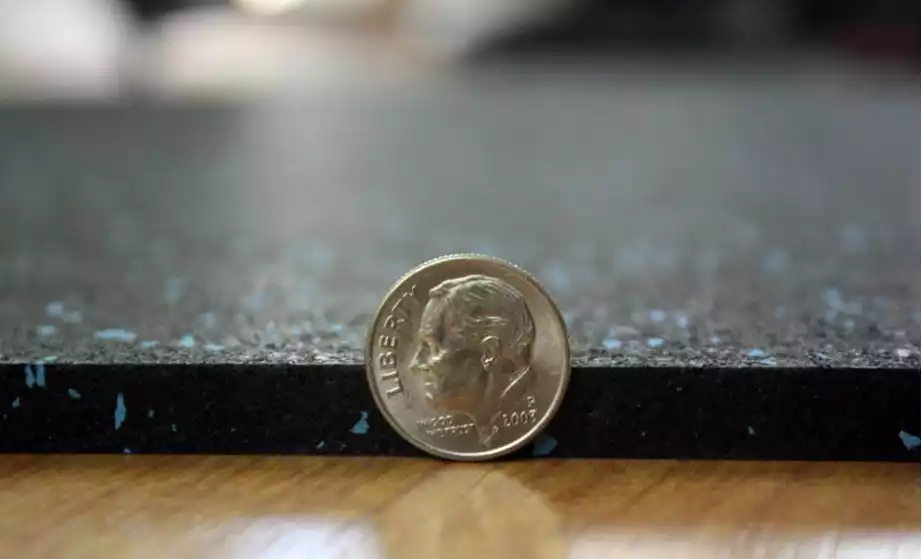
- Material: Recycled rubber buffings
- Dimensions: 4′ W x 15′ to 100′ L
- Thickness: Eight millimeters (5/16 inch)
- Suitable for: General weight training, HIIT
Check Price
- Free custom-cutting to any length over 15 feet (rounded to the nearest foot) with 20 color fleck variations available
- Five-year warranty on standard color options and a 25-year warranty on the Biggie Smallz
 colors
colors
- 30-day money-back guarantee
- USA-made
- Eco-friendly and made mostly from recycled rubber materials
- May have a rubber odor when it first arrives
- DIY installation may be challenging for some
- The rolls may curl or shift slightly over time
When it comes to outfitting your space with the best home gym flooring, the Rubber Flooring Inc. 8mm Strong Rubber Roll stands out as the ideal choice.
Unlike most flooring rolls that come in preset increments only (like 15, 50, or 100 feet), the 8mm Strong Rubber Roll can be ordered in one-foot increments starting at 15 feet. If your space is precisely 17 feet in length, for example, you can order that exact amount. Rubber Flooring Inc. will even custom-cut it for free and give you a couple of extra inches on each roll just in case.
This feature is underrated. With other companies, custom cuts aren’t available at all, so you’d be forced to buy a single 15-foot roll and leave two feet of your floor incomplete, or pay for two 15-foot rolls to cover the entire workout space just to be stuck with a bunch of leftover material.
The roll is available in 20 different color variations, from classic Black to Lipstick Red, so you can add some pizzazz to your rubber gym flooring.
The 8mm Strong Rubber Roll is made in the USA, which is appealing to those who want to support the American economy and value the higher standards that American manufacturing must meet. Rubber Flooring Inc. offers a five-year warranty on standard colors and an impressive 25-year warranty on its Biggie Smallz colors, which is one of the best warranties I’ve ever come across for rubber gym flooring. Plus, the company offers a 30-day money-back guarantee for customers in the United States and Canada.
colors, which is one of the best warranties I’ve ever come across for rubber gym flooring. Plus, the company offers a 30-day money-back guarantee for customers in the United States and Canada.
It will most likely emit a rubber odor at first since it’s mostly made from recycled rubber. The smell can be unpleasant, but to reduce it, you can air out the rubber roll and/or clean it with a mild soap and water solution before installation.
The installation might be a hurdle if you have no DIY experience. I did find the video in the company’s “Install Info” helpful, but you’ll still need a good understanding of how to use basic tools (measuring tape, t-square, and utility knife) and fundamental construction principles. If you have no experience in this field, calling a professional would be a smart decision.
Lastly, the rubber roll may curl or shift slightly over time with drastic temperature changes or if heavy things get dragged across it — like a fully loaded bumper plate tree. To prevent this, you can use double-sided tape to secure the rubber roll sticks to the floor.
Best Rubber Flooring for Home Gyms: Second Skin Stomp Roll
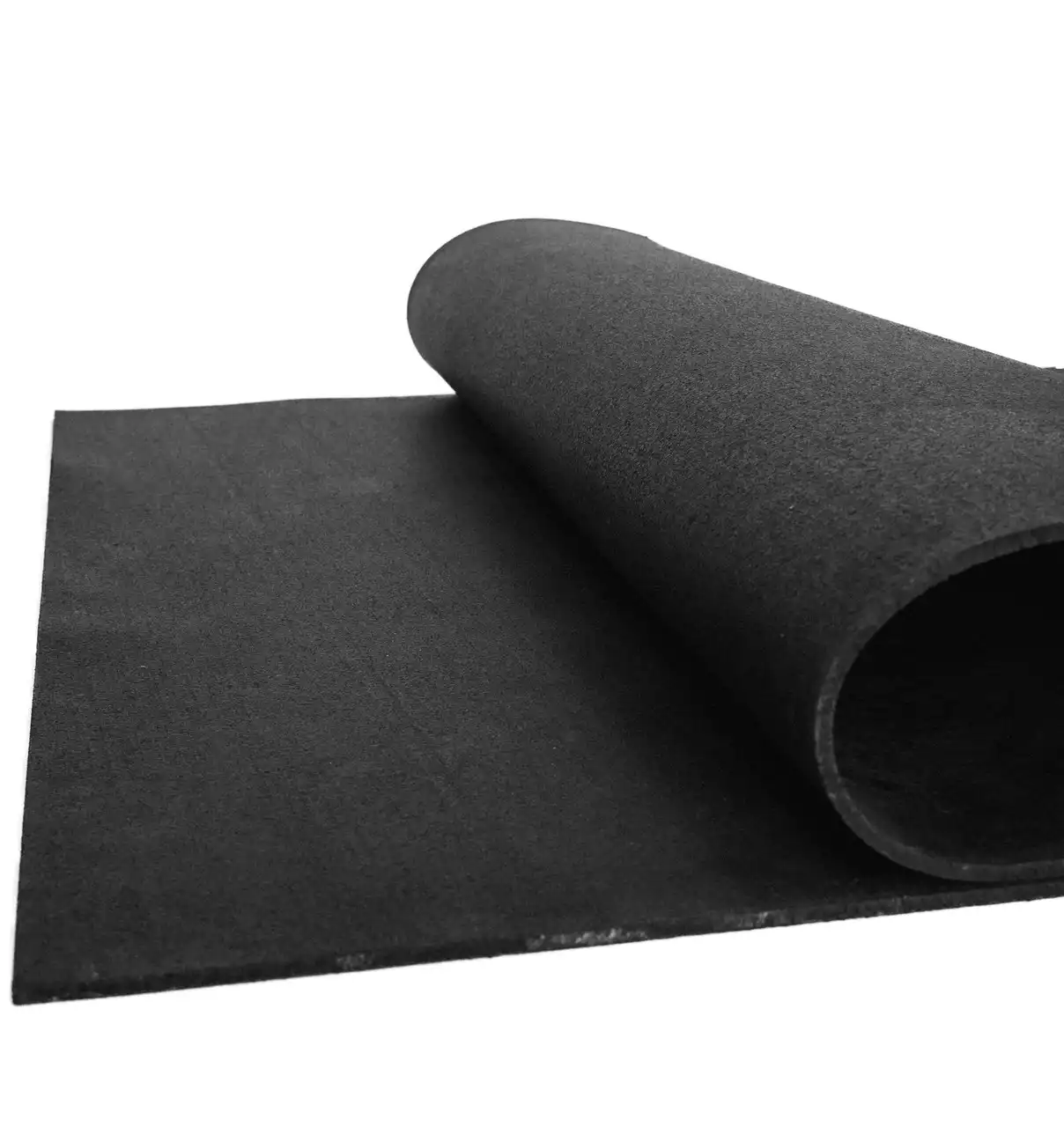
- Material: Recycled rubber
- Dimensions: 4′ W x 15′, 25′, or 50′ L
- Thickness: ¼ inch, eight millimeters, ⅜ inch, ½ inch, or ¾ inch
- Suitable for: General fitness, HIIT, powerlifting, and Olympic weightlifting
Check Price
- Five thicknesses that are suitable for low- to high-impact activities
- Includes noise-reducing technology
- Has a mild odor
- USA-made
- Made from recycled rubber materials
- Only available in black
- Custom cuts cost extra
- DIY installation may be difficult
If you are looking for rubber flooring that can reduce noise and vibration from your home gym equipment, you may want to consider the Second Skin Stomp Roll.
Second Skin is originally known for auto and audio soundproofing, but many of its products are also used in gyms due to their excellent noise and vibration dampening. This distinctive feature makes the Stomp Roll a solid choice for home gyms where quieter workouts are essential due to shared living spaces or the sleep schedules of young children.
With five different thicknesses to choose from, you’re almost guaranteed to find one that’s suitable for your exercise style. The quarter-inch thickness is great to place under any of the best treadmills or for bodyweight training, while the ¾-inch thickness is ideal for general weight training and HIIT. If powerlifting, CrossFit, or Olympic weightlifting is more your style, the ¾-inch thickness can provide enough protection for your floor when placed on top of plywood like on a lifting platform.
Despite being made from old tires, the Stomp Roll’s product page claims an “extremely mild odor.” I can’t confirm the strength of its smell but if true, this is a significant advantage over the many rubber flooring options that tend to off-gas unpleasant odors for weeks after installation. For those with asthma or other respiratory conditions (even just a sensitivity to scents in general), having near-odorless flooring can make a difference.
If adding flair to your rubber gym flooring is important to you, you’ll be disappointed to see that the Stomp Roll is only offered in black.
Furthermore, unlike the Rubber Flooring Inc 8mm Strong Rubber Roll mentioned previously, custom cuts of the Stomp Roll cost extra. Custom lengths are “available on request” and one customer even left a review saying, “I had a very custom project… They cut my pieces exactly as I asked for at a very fair price!”
While it’s great to know that you can get custom lengths other than the default 15-, 25-, and 50-foot lengths, I would be more impressed to see them offered at no extra charge.
The Stomp Roll’s installation process is simple but requires some basic DIY skills and understanding. If you’re not comfortable with self-installation, help from a professional may be necessary but will add to the overall cost. Keep this in mind, especially if you prefer a hassle-free setup.
Best Home Gym Flooring Over Concrete: Rogue Power Platform
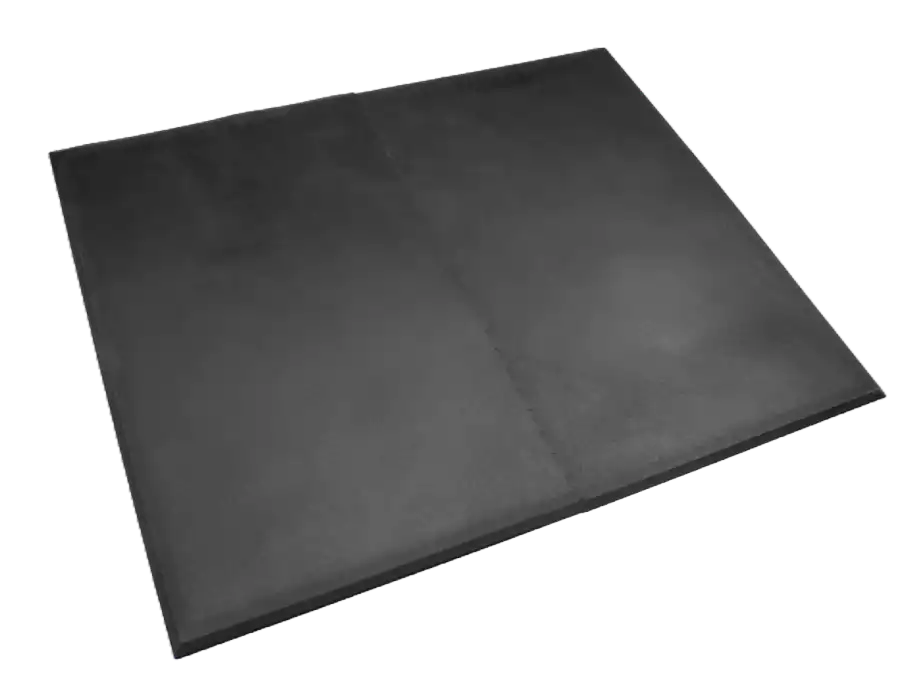
- Material: Recycled rubber
- Dimensions: 90” W x 72” L
- Thickness: ¾ inch (19 millimeters)
- Suitable for: General weight lifting, HIIT, CrossFit
Check Price
- The diamond-pattern top gives a good grip even when slick
- Can be used indoors or outdoors
- The ¾-inch thickness and waffle-pattern impact zones minimize noise and vibrations
- Easy installation due to the interlocking design
- Made in the USA
- Eco-friendly
- The fixed size might not suit all gym spaces and trimming it might damage the interlocking mat system
- Expensive compared to budget-friendly alternatives
- Potentially unstable with extremely heavy weights
The Rogue Power Platform is an excellent flooring choice for anyone with a concrete floor because of its durable rubber construction and waffle-pattern impact zones. The diamond-pattern top layer also gives it a better grip even in slick conditions, which is great for those who might prefer to have their home gym outside and work out in humid conditions.
RELATED: The Dangers of Outside Workouts
The ¾-inch thickness provides serious durability, making it ideal for general weight lifting, HIIT, and CrossFit. The waffle-pattern impact zones dampen noise and vibrations, which helps keep your concrete floor protected and your neighbors happy.
While it might seem extra-wide, the 90-inch width ensures that every weight plate on your favorite Olympic barbell will be supported with three inches on each side to account for occasional sideways movement. The default 72-inch length is surprisingly roomy and can accommodate two barbell setups for you and your workout partner when doing controlled exercises like deadlifts or rows.
The mats feature a modular, loose-lay interlocking system and sections with beveled edges. Installation is fairly straightforward with no adhesive required. For those not super DIY knowledgeable, this is a big relief.
However, its 72″ x 90″ footprint may not suit all spaces, and trimming it might damage the interlocking mat system.
If you’re into Olympic lifting, the Power Platform isn’t the best choice. At 72” long, this is the minimal length you should accept for weightlifting. While it technically could work, your feet could land beyond the perimeter of the platform during a split jerk if you have long legs. In the event of a bailed lift, it’s only a matter of time before a failed snatch or clean and jerk lands off the platform and damages your floor. A better option for Oly lifting is the Rogue 8′ x 8′ Oly Platform.
The Power Platform is also more costly at $399 compared to budget-friendly alternatives like 4′ x 6′ horse stall mats from Tractor Supply, where a single mat can be found for around $60. Two horse stall mats would total roughly $120 and, when joined together, would offer a bigger platform for less than half the cost.
Finally, the platform might be less stable with ultra-heavy weights due to the rubber material. After all, there’s a reason why lifting platforms usually have a centerpiece made out of wood — it’s more firm than a rubber surface. While this would probably be unnoticeable with light to moderate weights, it’s worth pointing out for those who want to lift heavy.
Best Home Gym Flooring Over Carpet: Second Skin Stomp Mat

- Material: Recycled rubber
- Dimensions: 4′ W x 6′ L
- Thickness: ¼ or ½ inch
- Suitable for: Bodyweight training, general weight lifting, HIIT
Check Price
- Shock-absorbing properties to protect your floor from damage, whether it’s from a treadmill or barbell
- Includes noise-reducing technology
- Installation is a breeze
- No adhesive needed
- USA-made
- Eco-friendly
- No ¾-inch thickness
- Costly
- Even when weighed down by heavy equipment, these mats can shift slightly over time
The Stomp Mat offers several advantages that make it the most appealing choice and the best home gym flooring option to place over carpet. With its shock absorption capabilities, it safeguards your carpet fibers from getting torn up while also protecting your existing subfloor from damage.
The ¼-inch mat weighs 30 pounds (13.6 kilograms) and provides excellent noise reduction, making it a great option for supporting standalone exercise equipment like a high-quality rowing machine or treadmill. The weight of the machine on top of the mat tends to keep it in place. The ½-inch thick mat, on the other hand, weighs 60 pounds (27.3 kilograms) and offers even more sound isolation and flooring protection.
The Stomp Mat lacks a ¾-inch thickness option. This limits its suitability for powerlifting-style training because it may not be able to handle significantly heavier weights. It’s also not a great choice for Olympic lifting or CrossFit because the thinner options won’t be able to withstand repeated weight drops from overhead.
Additionally, it’s relatively costly compared to budget options. The ¼-inch mat is priced at around $99.99, and the ½-inch mat costs around $179.99. A ¾-inch horse stall mat from Tractor Supply Co. costs about $60, offering more thickness at a lower price.
Because it’s a mat instead of a roll, installation is a breeze. Simply lay it over your carpet, and place your equipment on top or get lifting.
You technically don’t need adhesive, but double-sided flooring (carpet) tape or rubber adhesive applied around the edges of the mat is a wise choice. Even when weighed down by heavy-duty cardio machines, these mats can shift slightly over time. If using multiple mats, you can also place mending plates under the mats where their seams join to keep them from separating over time.
Best Home Gym Flooring Over Hardwood: REP Fitness 3′ x 4′ Floor Mats
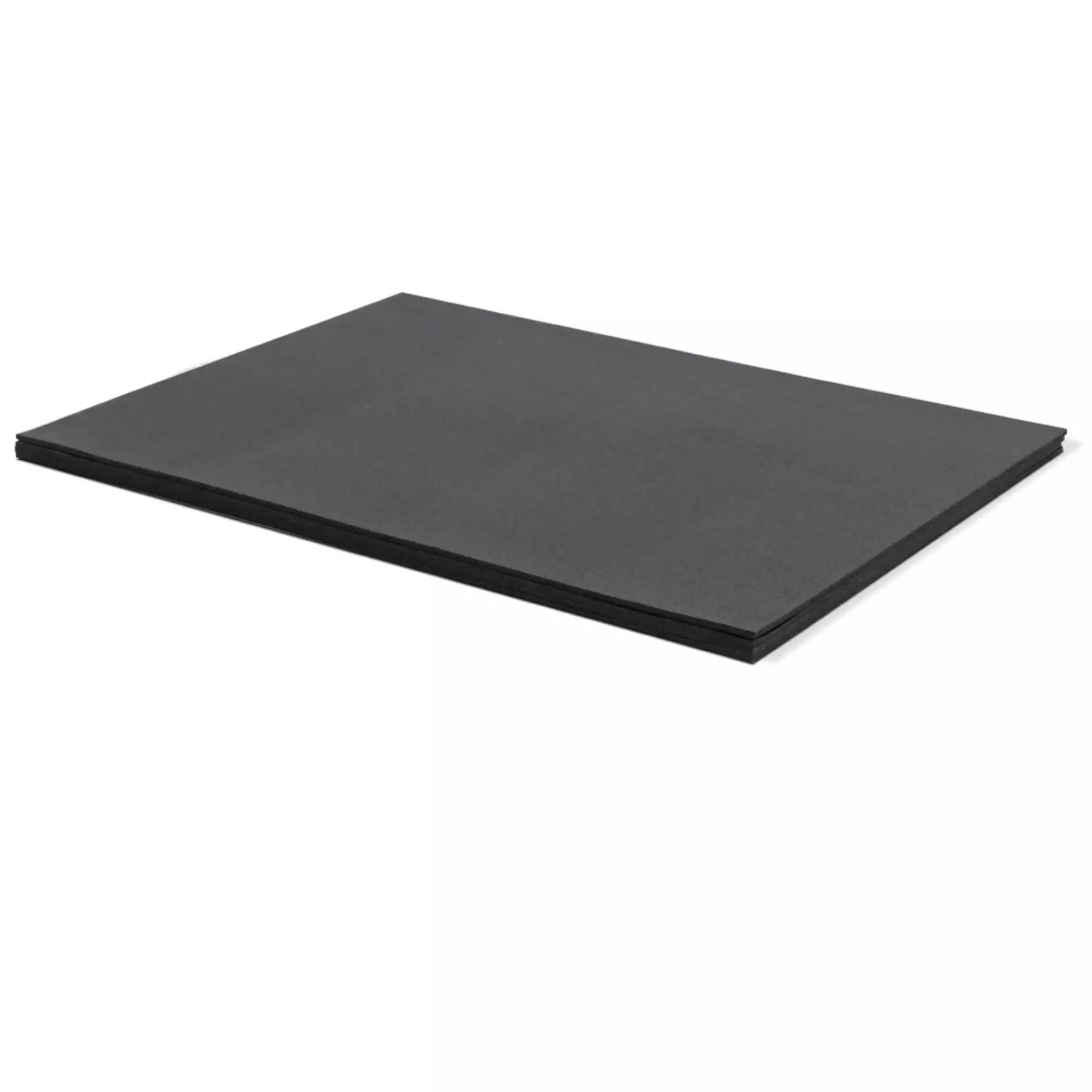
- Material: Rubber
- Dimensions: 3′ W x 4′ L
- Thickness: ⅜ inch
- Suitable for: General weight training, HIIT
Check Price
- Smooth top makes floor exercises like sit-ups and push-ups more comfortable
- Textured bottom helps prevent the mats from slipping
- ⅜” thickness can help protect your hardwood floors from general weight training
- No odor
- USA-made
- The mats have a ½-inch tolerance, so small gaps between mats can happen
- Roughly the same cost as horse stall mats, but only half the size
- Not thick enough to protect your floors from heavy lifts or dropped bars.
The biggest feature that stands out to me with the REP Fitness 3′ x 4′ Floor Mats is the non-grooved, textured bottom. Horse stall mats have slots or grooves on the underside for improving drainage. This is great for livestock and industrial applications but serves very little purpose in a home gym. Instead, a fully flat underside lets the entire mat have complete contact with your floor. In addition to the textured underside on REP’s floor mat, this combo ensures that the mat doesn’t slip, and we think this makes it the best choice to put over your hardwood floor.
REP Fitness went a step..



